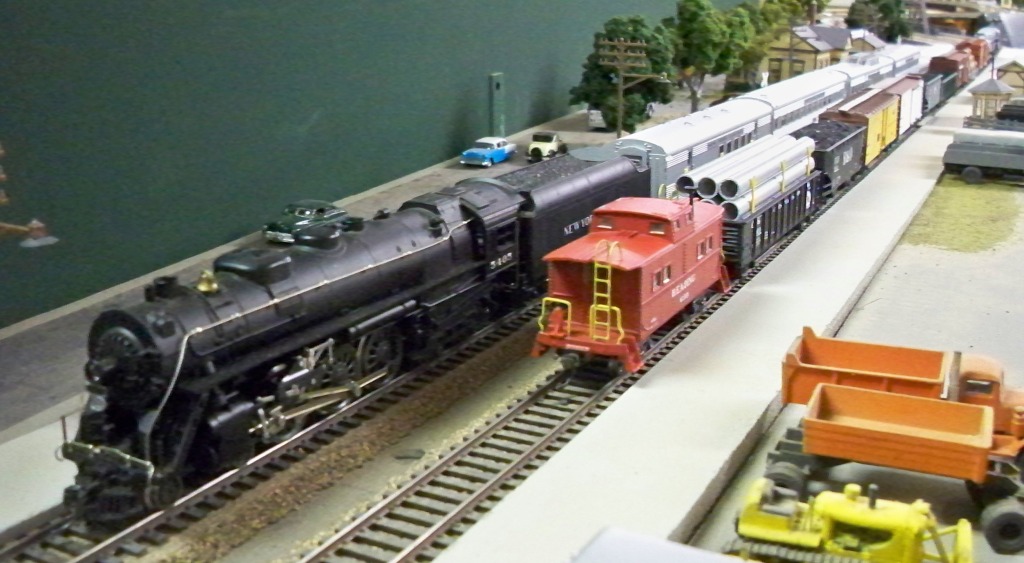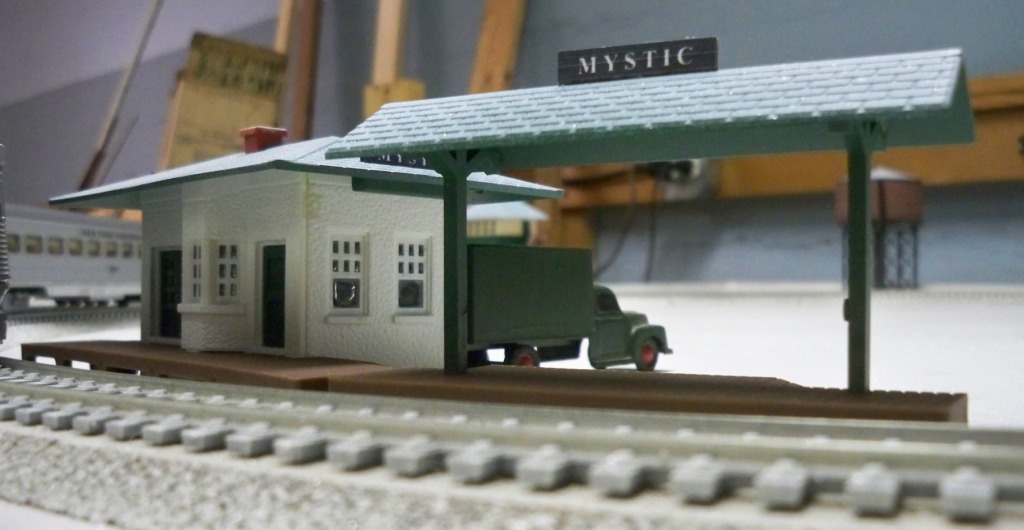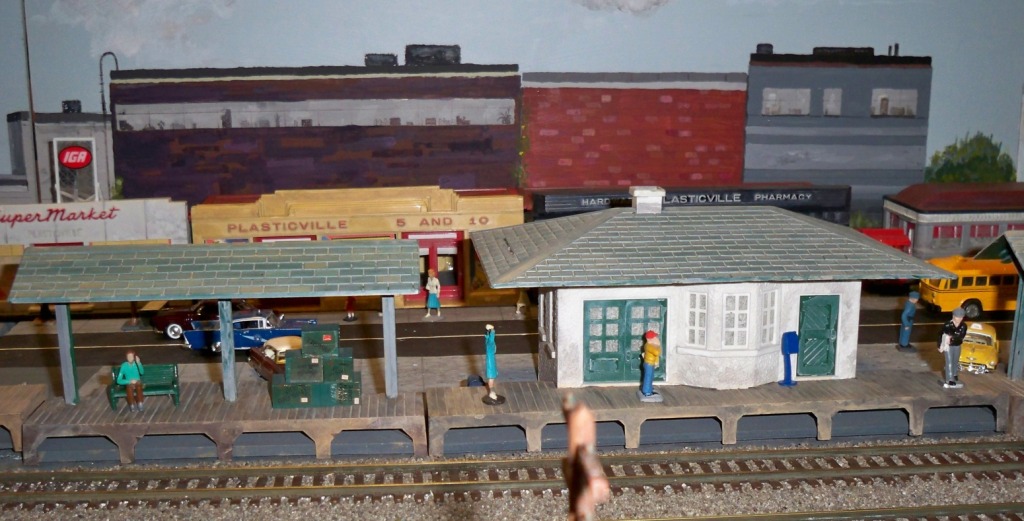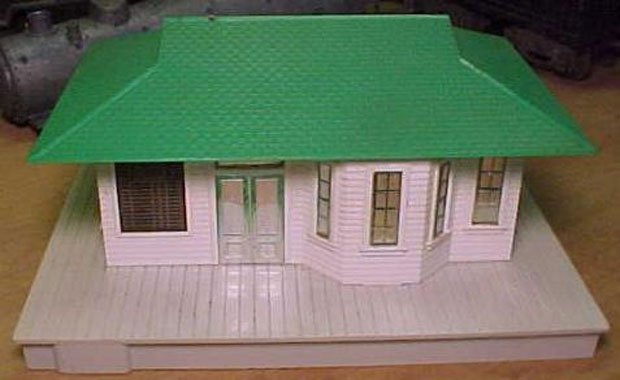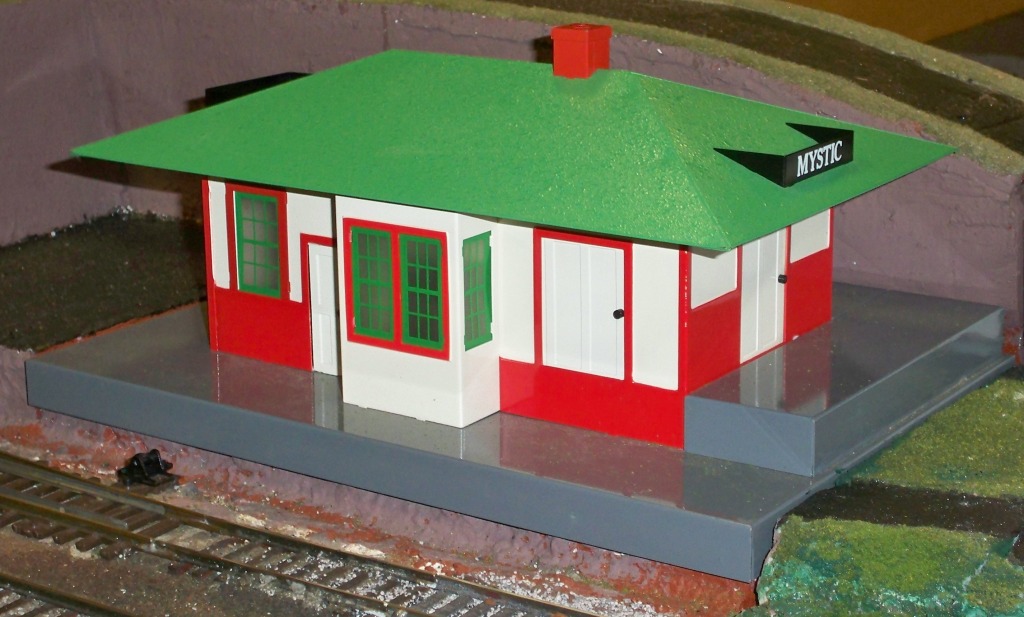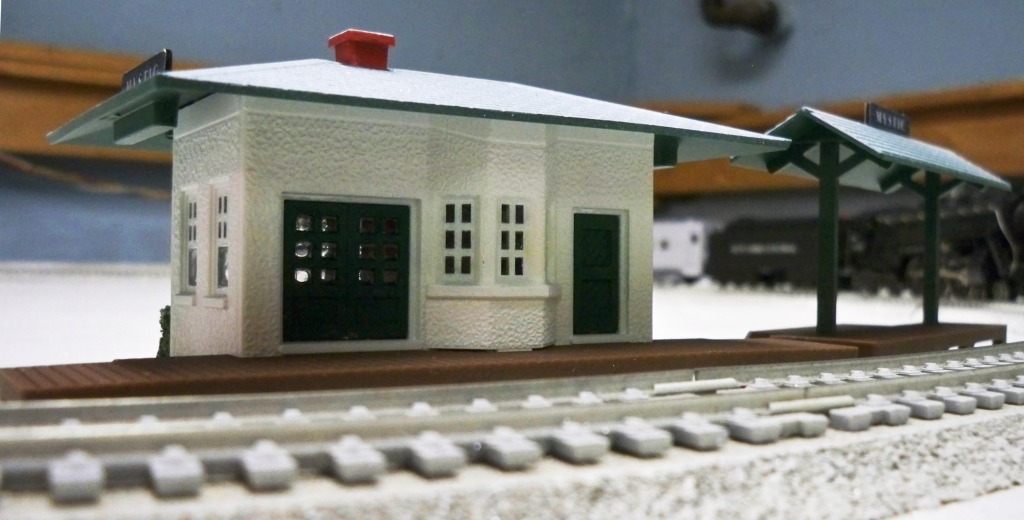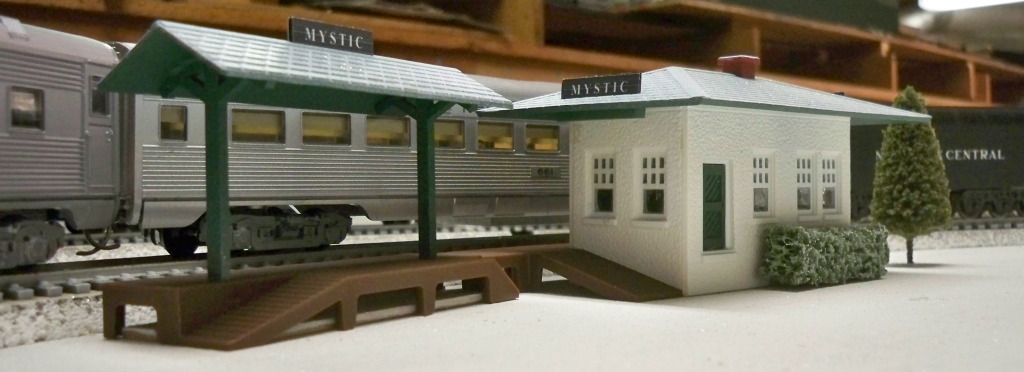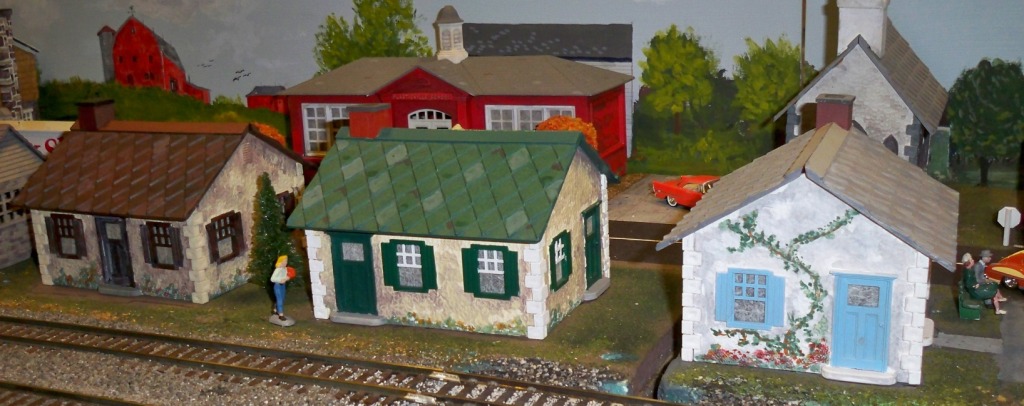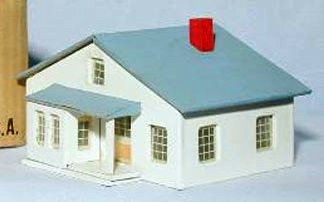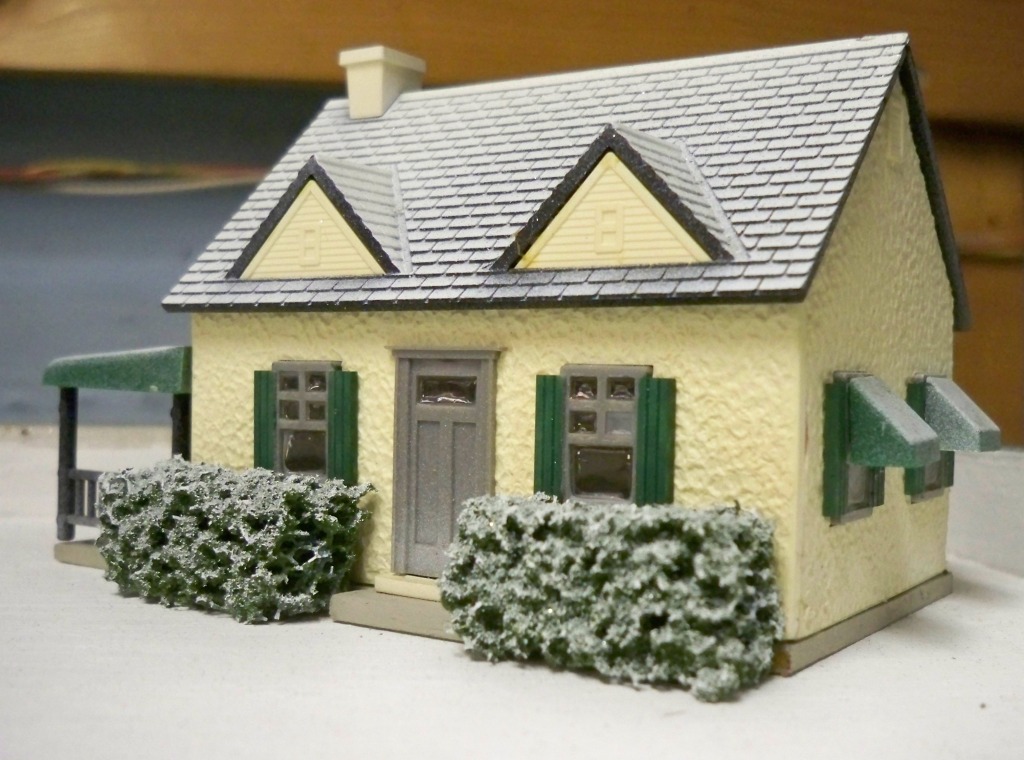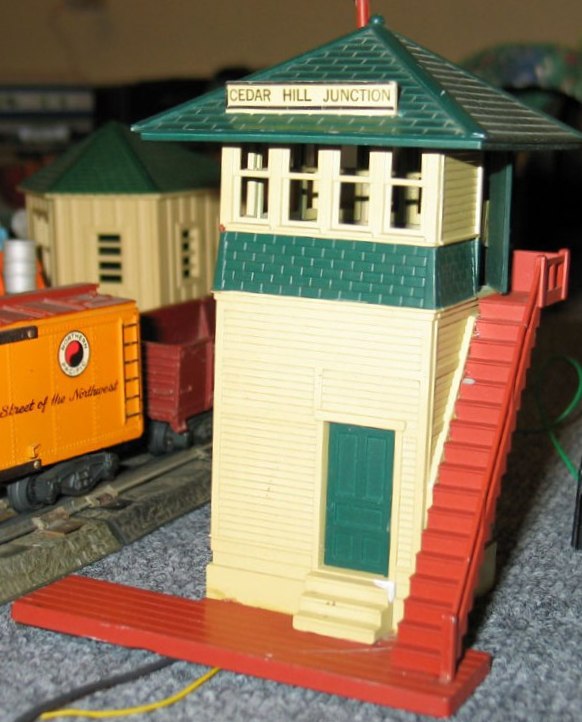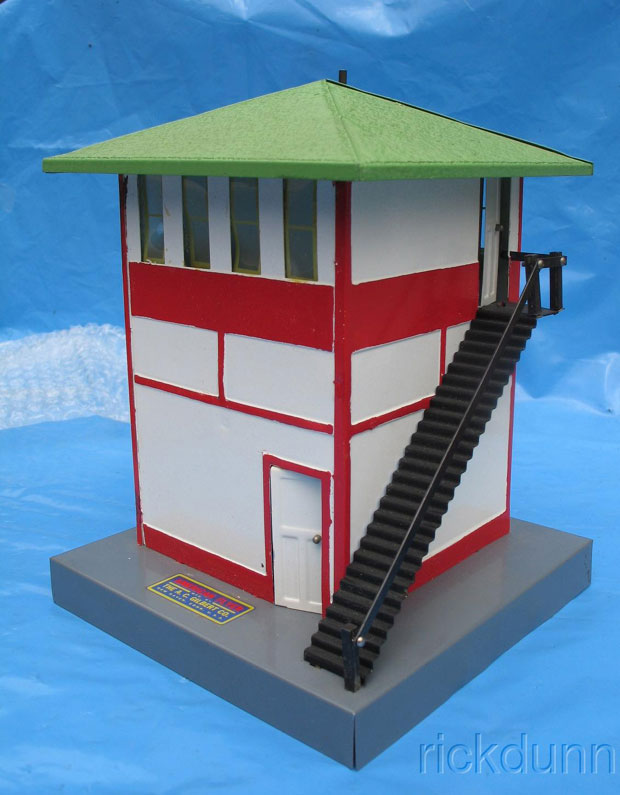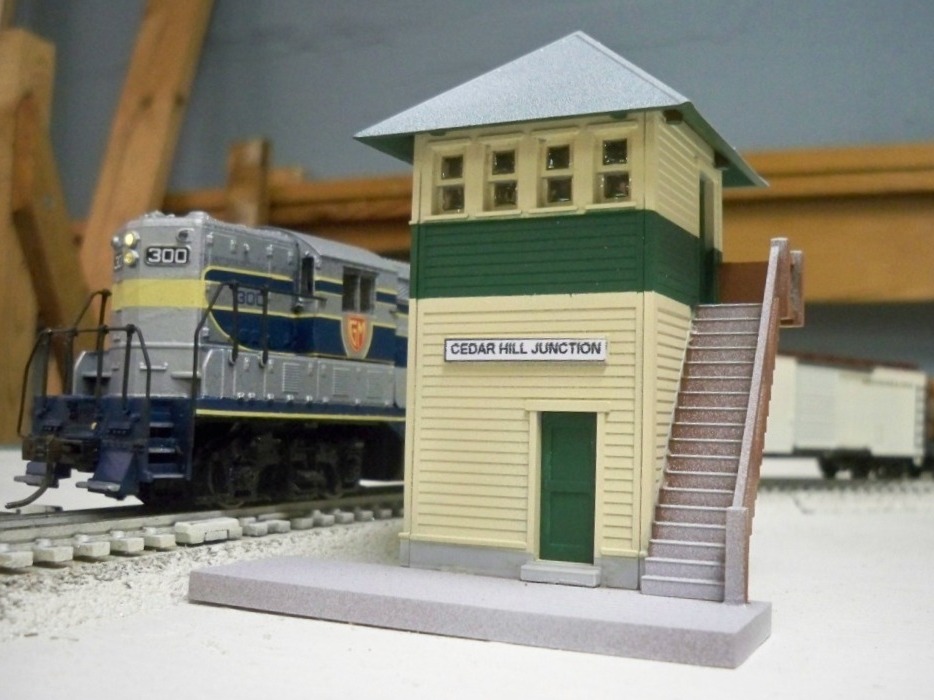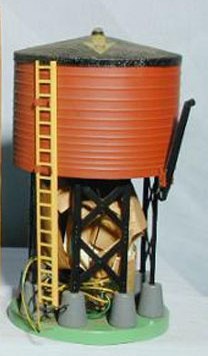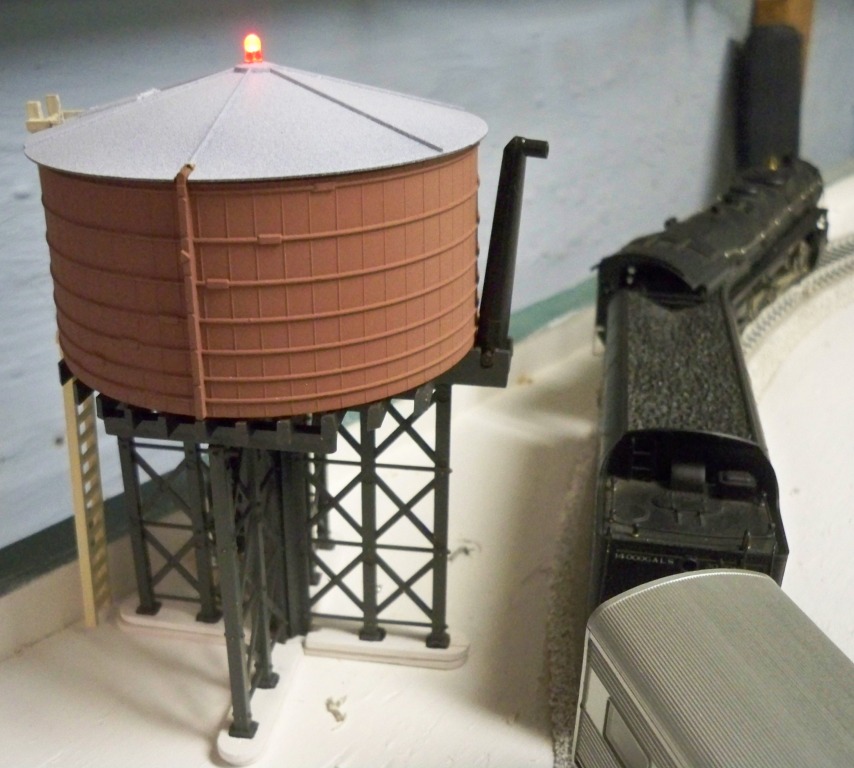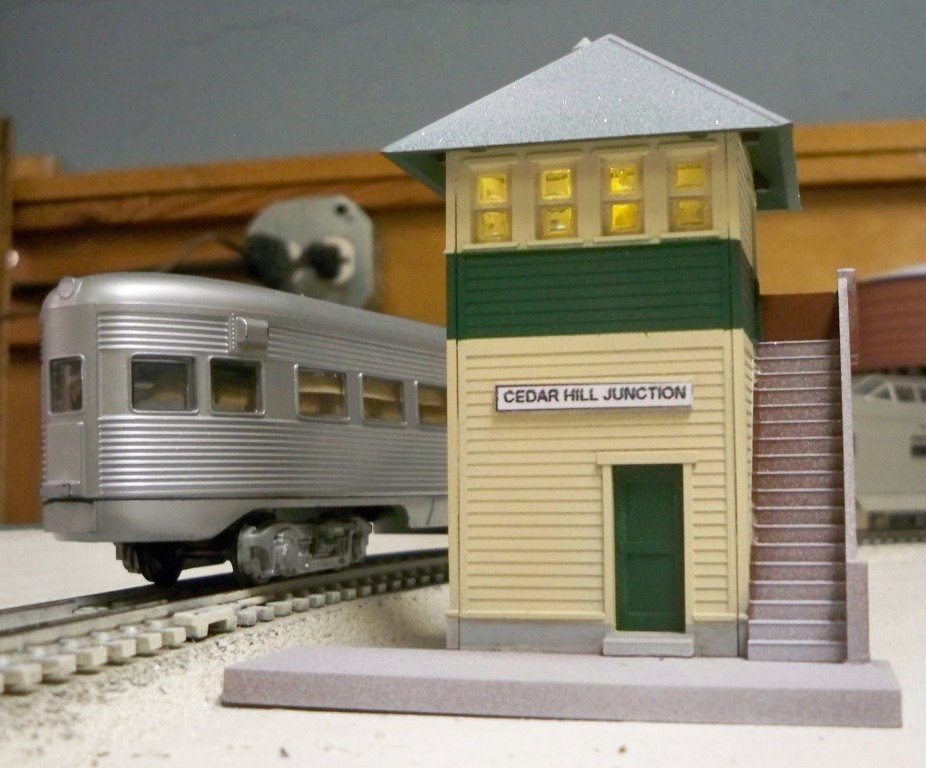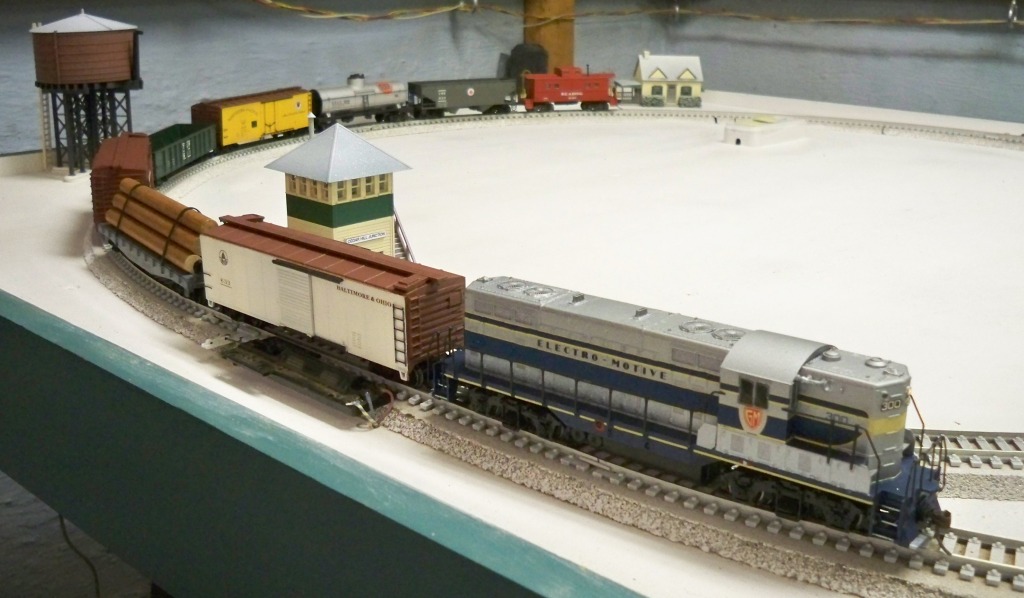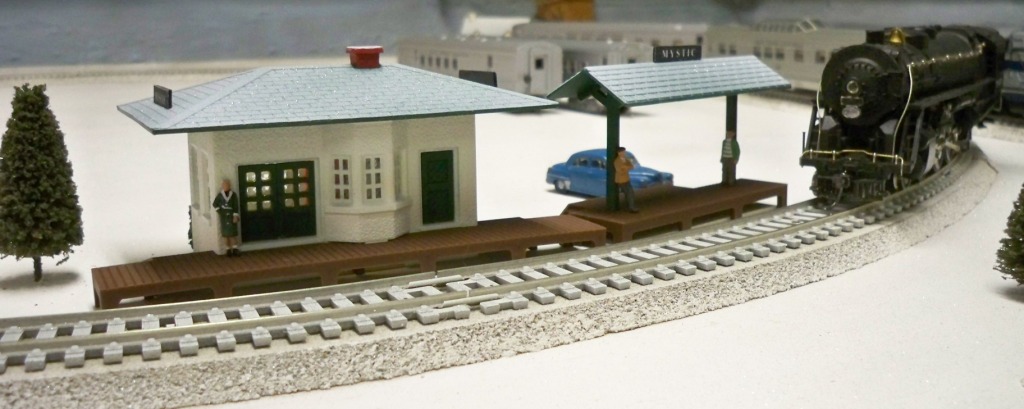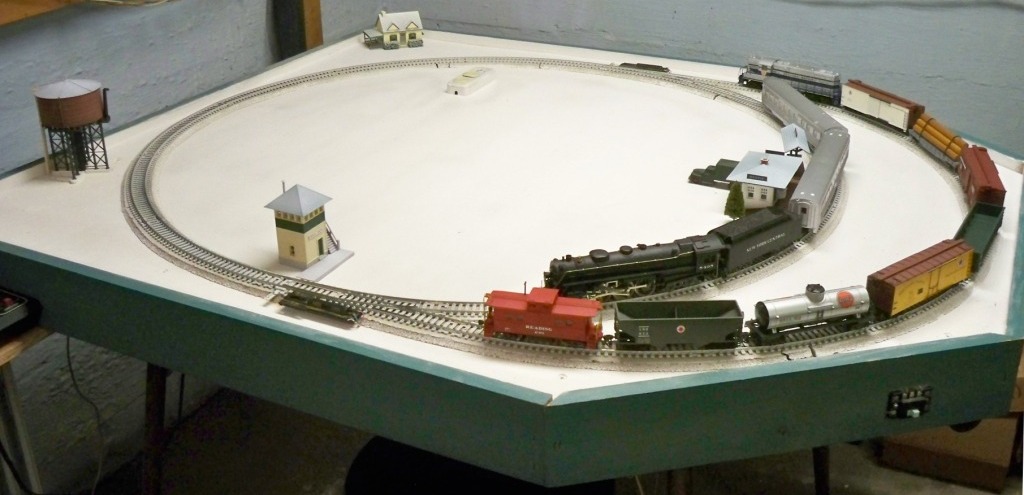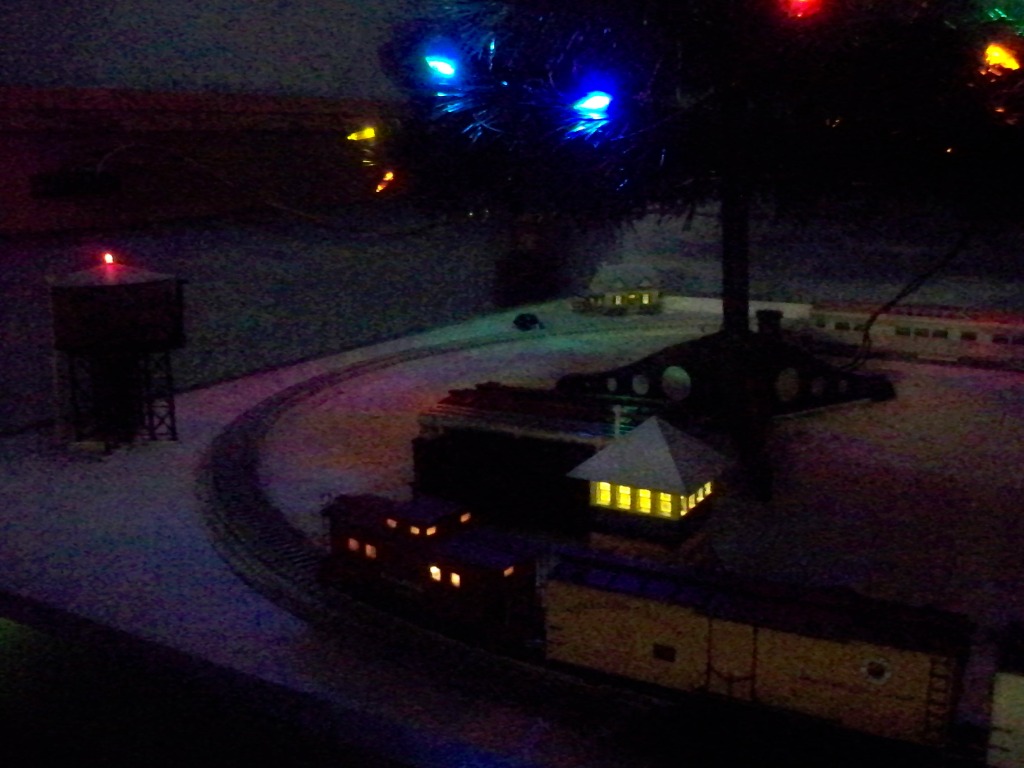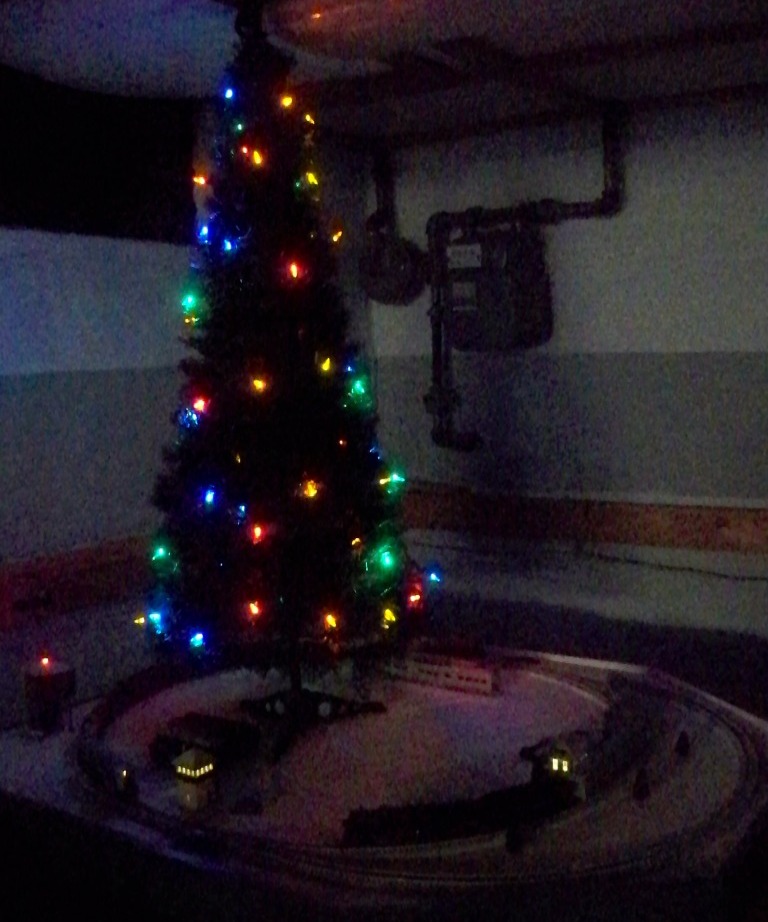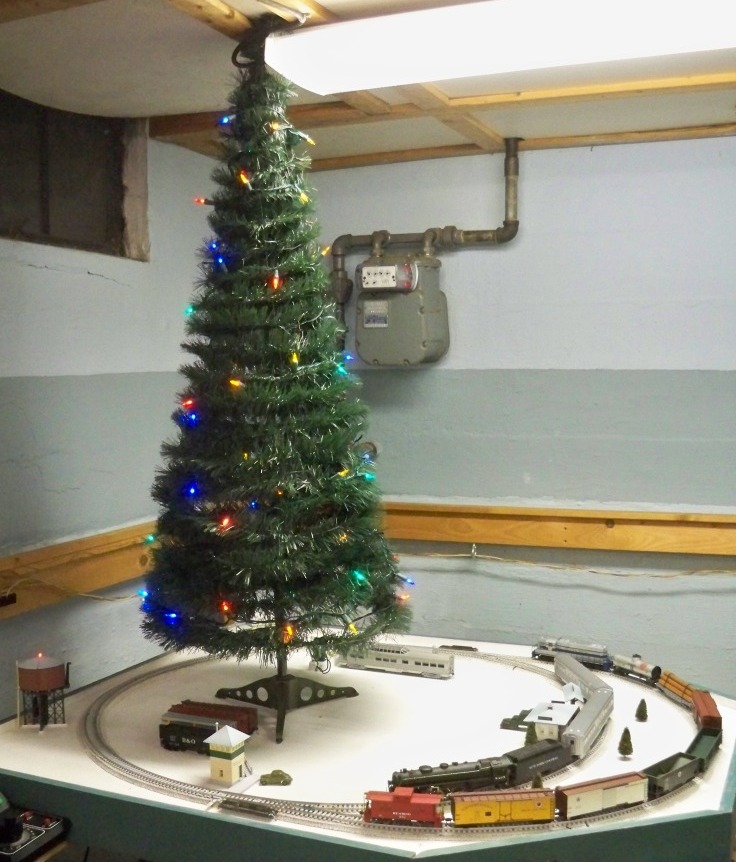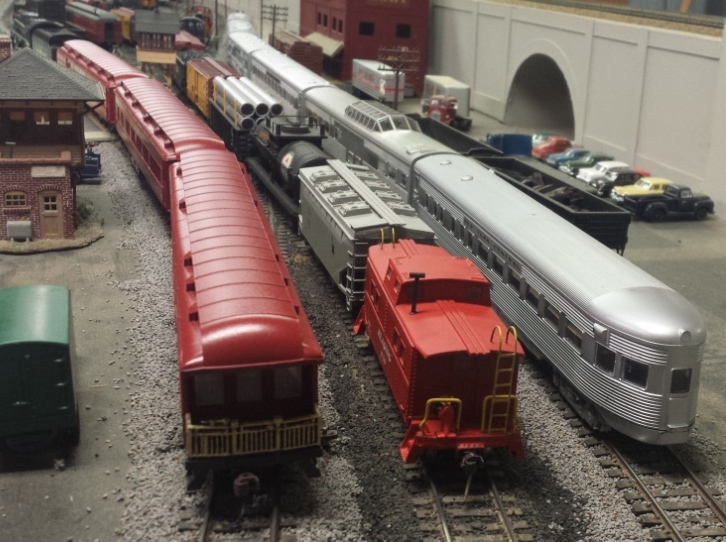FAUX FLYER FROLIC
Except where otherwise noted,
American Flyer S-gauge items displayed on this page were photographed by the
author at local model train shows.
We are grateful to other photographers and collectors whose work is also displayed
here in reduced resolution.
We urge viewers to view the original works at their outstanding websites.
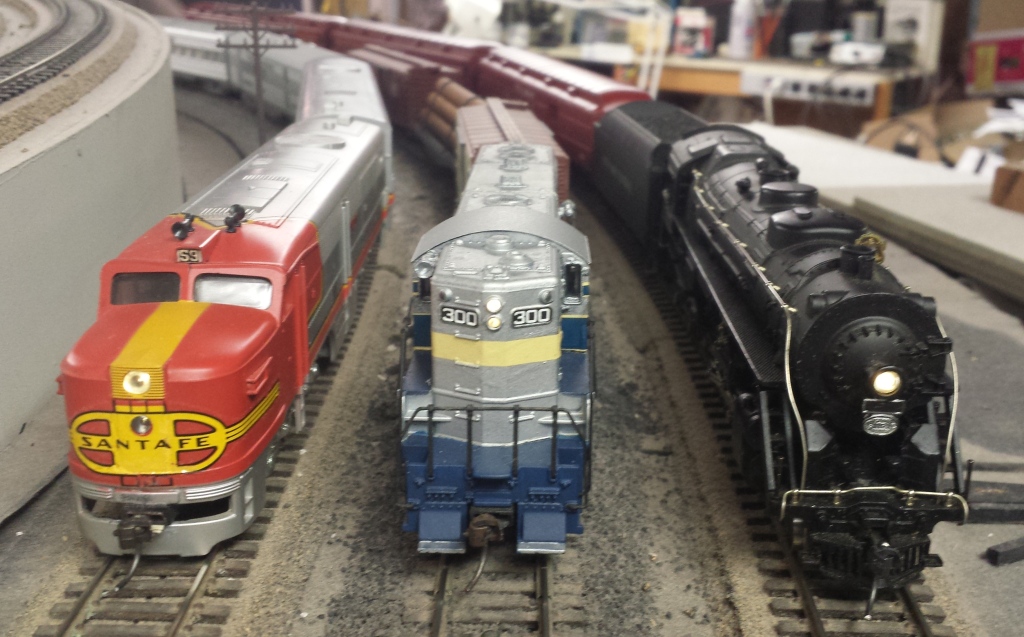
If you've come to this page hoping to find information about luggage
or bicycle racing, sorry, it's not that kind of "American Flyer." If
you've wandered onto this page with no idea of what "American Flyer" has
signified in the minds and hearts of American kids from the 1930s through the
1960s, even until
well after these kids have grown old, think: "like Lionel trains—only different."
For more in-depth background, you might want to switch to the branch line to "Notes
on American Flyer Trains" before proceeding.
But if you've heard of A. C. Gilbert, if you know what "S-scale"
means, and if you can tell a Geep from a Hudson, you're clear and green to
highball down the main! ▼
▼ON THIS PAGE▼
Everything Old Is
New Again
Video of Faux Flyer in action
Faux Flyer:
American Flyer Look-Alikes
Equipment Roster
LOCOMOTIVES
FREIGHT CARS
PASSENGER CARS
Structures
BACHMANN – PLASTICVILLE
Outlook
▼ON THIS WEBSITE▼
My
"American Flyer" Experience
Origin,
History, and Details of the Faux Flyer Project
Notes on...
American Flyer Trains
Plasticville
Structures
▼VIEWABLE
ELSEWHERE▼
Websites for Those Who Demand Genuine American Flyer
American Flyer Club
American Flyer Displays
The Gilbert Gallery
My Flyer Trains
(Chuck)
I'm a serious model railroader.
I model Baltimore & Ohio and connecting operations in the Appalachian region
during the mid 1950s, and my chosen scale is HO (1:87). I'm picky about
getting my equipment to look as close to the real thing as I can manage with
my aging eyes and shaky hands.
However, when I'm at local train shows,
the inner child in me can't help being drawn to the American Flyer displays,
which call to mind my own interests at that long-ago time in my life. I
fancy I'd really enjoy once again having an American Flyer S-gauge train
chugging around the tree at Yuletide. But these days, such
equipment is ancient. Most of it has been run to death by kids, and has
long since been gradually deteriorating in dusty attics and damp basements.
It would require much expense and effort to acquire, repair, and maintain, not
to mention the space to build and store an S-gauge layout on which to run it.
Then it strikes me: Forget
buying and refurbishing actual Flyer equipment, and building an S-scale
layout. American Flyer modeled real prototype equipment, the same
(almost) as HO does. And I already have an HO layout. So the
obvious solution is:
Model American
Flyer in HO!
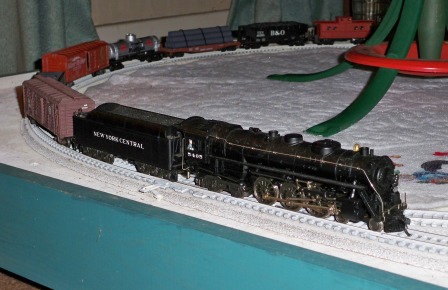
Under
the tree, this HO stuff could easily be mistaken for American Flyer or
Lionel—if you don't look too closely!
This early phase was an experiment, done
on-the-cheap. I didn't want to spend a lot on something that might turn
out not to hold my interest, or that a playful cat might damage. So most
items here were retrieved from my own discard box, with the exception of the
locomotive (purchased on eBay) and the flat car (an inexpensive,
throw-together kit).
The project took a few years, passing through
an initial "hand-me-downs" phase (2009-2011) and a "prototypes" phase
(2011-2013), before my evolving idea of what I wanted and
the evolving product finally coincided. If you love "process" and
"background,"
click here to view the origins and previous phases of the Faux Flyer project.
But if you're mainly interested in results, just continue scrolling
down the rest of this page.
|
Faux Flyer: American Flyer
Look-Alikes |
In the "Flyer Look-Alike" phase, available HO model equipment is selected
and modified to resemble corresponding units in American Flyer's S-scale
line. Modification includes adjusting details (such as ladders and
roof walks), painting and lettering, and (where a load was included with a
Flyer freight car) recreating the loads.
There are limits to this "look-alike" plan. A car or locomotive
already decorated and numbered for a desired prototype is left as is.
But when I redecorate a car specifically for the Faux Flyer roster, in
most cases I apply (as nearly as I can duplicate them) Flyer's colors,
road names, lettering, and numbering. Exceptions include units
representing S-gauge equipment lettered for "American Flyer" or "American
Flyer Lines," which are mostly locomotives and passenger cars. These
are lettered for the prototype railroad (if decals are available).
As to numbers, locomotives (of which there are currently only two) receive
prototype numbers, but passenger cars are numbered according to Flyer's
practice.
Most early
post-war American Flyer equipment was lettered in a uniform
G O T H I C font, even though most prototype railroads
of the time used
R O M A N
lettering. In decorating the Faux Flyer equipment, in most cases I've used
prototype lettering styles, since decals of these are what's commercially available to modelers,
most of whom model
prototype equipment, not toys. But for units on which there are no long road
names or other lettering strings, I can piece together the individual
characters from an alphabet-number decal sheet to match what's on the
Flyer car: black Roman for the C&NW flat car, white Gothic for the LNE
hopper car, etc.
|
|
Equipment Roster
LOCOMOTIVES
|
PASSENGER CARS
| FREIGHT CARS
| STRUCTURES |
The table below displays the
original American Flyer S-gauge equipment side by side (or one over the
other, in the case of locomotives) with my HO replications of it.
|
Locomotives
LOCOMOTIVES
|
PASSENGER CARS
| FREIGHT CARS
| STRUCTURES |
Steam: the New York Central "Hudson"
Despite that I never owned one, American Flyer's Hudson has a double
appeal for me. On Flyer's steam roster, it was a coveted prize,
second only to the stupendous Union Pacific class FEF-1 4-8-4 "Northern"
type. The Hudson also represented one of the real locomotives that
daily charged through my home town. And on a few occasions, New York
Central's Hudsons (J-1's or J-3's) faithfully hauled me home after
I'd been visiting my grandparents in Cincinnati, until the last of the
Central's steamers were replaced by diesels in 1956.

American Flyer #320-326 4-6-4 "Hudson" type, New York Central class J-3a
(Photo:
http://www.thegilbertgallery.org)

Rivarossi 4-6-4 "Hudson" type, New York Central class J-3a 5405
(original, low-grade model, used)
The Rivarossi Hudson wears its original paint and lettering,
except that the cylinder heads are changed from silver to black. I don't
think the engineer was standard equipment on this model. However, he
came with this pre-owned engine, and is welcome
to stay as long as he enjoys the job and is willing to work for free!
There were several variants
within the prototype New York Central's sub-class J-3a. The most
obvious of these were between streamlined or unstreamlined versions, and
between 14-wheel "centipede" or 12-wheel conventional tenders.
Additional options included Scullin-disk or Box-Pok type driving wheels,
and rectangular or cylindrical feedwater heaters. NYC's number 5405
was an unstreamlined engine with a 12-wheel tender, Box-Pok drivers, and a
cylindrical feedwater heater. This combination was the prototype for both
American Flyer and Rivarossi models.
|
Diesel-Electric: GM's Electro-Motive GP-7
The "Flyer look-alike" project poses a problem for my Baltimore & Ohio
GP-7. My research has revealed that American Flyer did not produce
any Geeps in B&O paint. So, since I'll sometimes be running mine
on the big B&O layout in the cellar, I must find a road name in which
Flyer produced its Geep that might credibly be found on B&O rails during
the early 1950s. Looking at the target production years of 1950 through 1957,
I find that Flyer's Geep was produced in Texas &
Pacific, Union Pacific, and Chesapeake & Ohio road names. The T&P and UP were western
roads completely outside B&O territory. And the C&O, though it was
in B&O's area, was also a bitter rival at that time, and not likely to be sharing
trackage with B&O except in limited interchange or emergency service. This leaves one
possibility: the Electro-Motive GP-7 demonstrator, the first color scheme
in which Flyer offered its Geep when it was brand new. The
Electro-Motive division of the real General Motors had
produced three GP-7 demonstrator units, numbered 100, 200, and 300.
These toured many
American railroads between 1950 and 1954, the B&O probably among
them.
American Flyer had a reputation for
good quality modeling (by the standards of the day). In 1950, the company
introduced models of two new diesel locomotives: an Alco PA- PB set that lived up
to this reputation, and an EMD GP-7 that did not.
Aesthetically, Flyer's GP-7
was horribly botched, starting with the trucks, whose gross oversize might
have been attributable to mechanisms borrowed from the larger Alcos.
From this key error of geometry, there ensued a cascade of other errors in
an apparently panicked attempt to compensate. (Even Lionel's O-gauge
Geep looked more realistic!) And to add insult to
injury, Flyer's paint scheme was a crudely stingy reduction of the
prototype's strikingly handsome markings.
Still, these units performed
well (considering only four of the eight wheels were powered), and in the 1950s Flyer sold a fair
number of them to an uncritical consumer base, to whom Geeps were a
brand new, and thus not yet familiar, phenomenon. Flyer's early GM
units were typically included in short work-train sets; the later T&P, UP,
and C&O units were packaged with military and freight train sets of up to
six cars.

American Flyer #370 EMD GP-7, General Motors demonstrator (simplified)
(Photo by author at Dayton Train Show.)
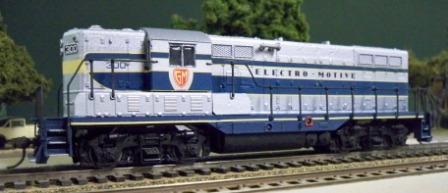
Athearn EMD GP-7 demonstrator, GM 300
(modified, redecorated, budget model,
r-t-r)
For this project, my old B&O
Geep is partially de-modified from passenger
service (roof-mounted "torpedo boat" air tanks are removed), and directional LED headlights are installed. Cab window
glazing is Microscale Kristal-Klear. Added
details, color scheme, and numbering conform to the prototype GM 300.
Paint: Polly Scale flat
aluminum (body), caboose red (fuel fillers), and engine black (trucks and
underbody); Modelflex B&O royal blue
Decals: Microscale 87-1003
Athearn's GP-7 suffers from
the distraction of a slightly wider than scale hood, necessary to accommodate the
open-frame HO motors of the 1950s. Consequently, the Athearn
unit's "chisel-nose" ends have a curiously blunt appearance. But this minor deformity is
insignificant compared to Flyer's bungled attempt to approximate EMD's
then-newest product. So, in this case, the "Flyer look-alike" effort is
set aside, in order to create a model that looks, not like Flyer's, but as
Flyer's should have looked, had it stuck to its established
standard of quality. (Indeed, American Flyer's 1950
catalogue depicted the unit in (more or less) prototype geometry and
paint. Evidently, the marketing artist hadn't yet seen Gilbert's
production model!)
●
Diesel-Electric: Santa Fe Alco PA/PB-1
Eventually I decided to abandon
any pretext of justifying the running of foreign-road equipment on my B&O
layout. I had now accumulated three Faux Flyer trains, but only two
locomotives to haul them. The GP-7 was dedicated to the freight
train, but the NYC Hudson had to do double-duty, switching off between the
two passenger sets: the red heavyweights and the silver streamliners.
I decided that, if I could find one at a reasonable price, I'd add a
look-alike for Flyer's 36x series Santa Fe Alco PA/PB set to haul the
streamliners. Fancy that: a pair of flashy silver Alco's in Santa
Fe's wild-west red war-bonnet scheme, plying the Alleghenies! Oh well, it'll
only be for the holidays, I told myself.

American Flyer #36x Alco PA-1 / PB-1 in Santa Fe's red "war-bonnet"
scheme
(Photo courtesy of The Gilbert Gallery.)
At the model railroad show in
the autumn of 2017, I found and purchased a used Athearn set of Alcos for
a fraction of the price that such items were fetching on eBay.
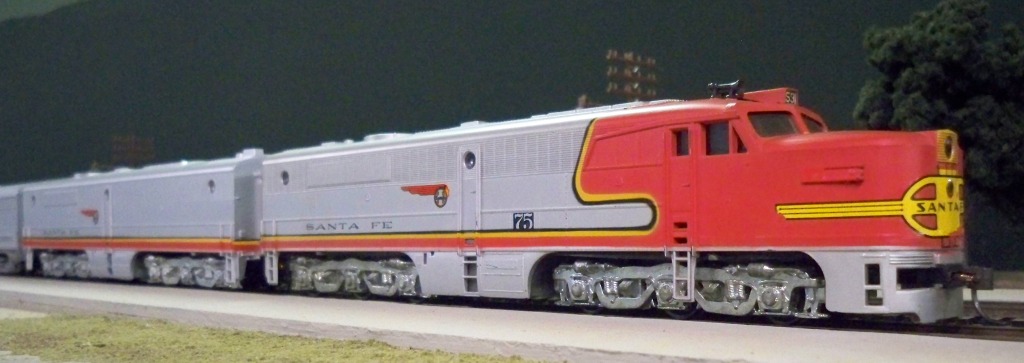
Athearn Alco PA-1 / PB-1, ATSF #75
(budget model, r-t-r)
As with the S-gauge American
Flyer Alcos, only the lead cab unit is powered; the booster unit is a
dummy. Once properly lubricated and
adjusted, the Athearn unit runs well enough, albeit rather noisily.
It had a few superficial blemishes, but these have since been touched up,
and a directional LED headlight has been added.
As replacement power for the
Hudson on the streamlined passenger train, the Alco PA and PB units
together are longer than the Hudson and its tender. However, the
Hudson can't run without its tender, but the Alco cab unit can run without
the booster. By itself, the cab
unit is short enough that the train length on the small Yule
tree layout can be extended, from two cars with the Hudson, to three with
the PA.
|
Freight Cars
LOCOMOTIVES
| FREIGHT CARS
|
PASSENGER CARS
| STRUCTURES |
|
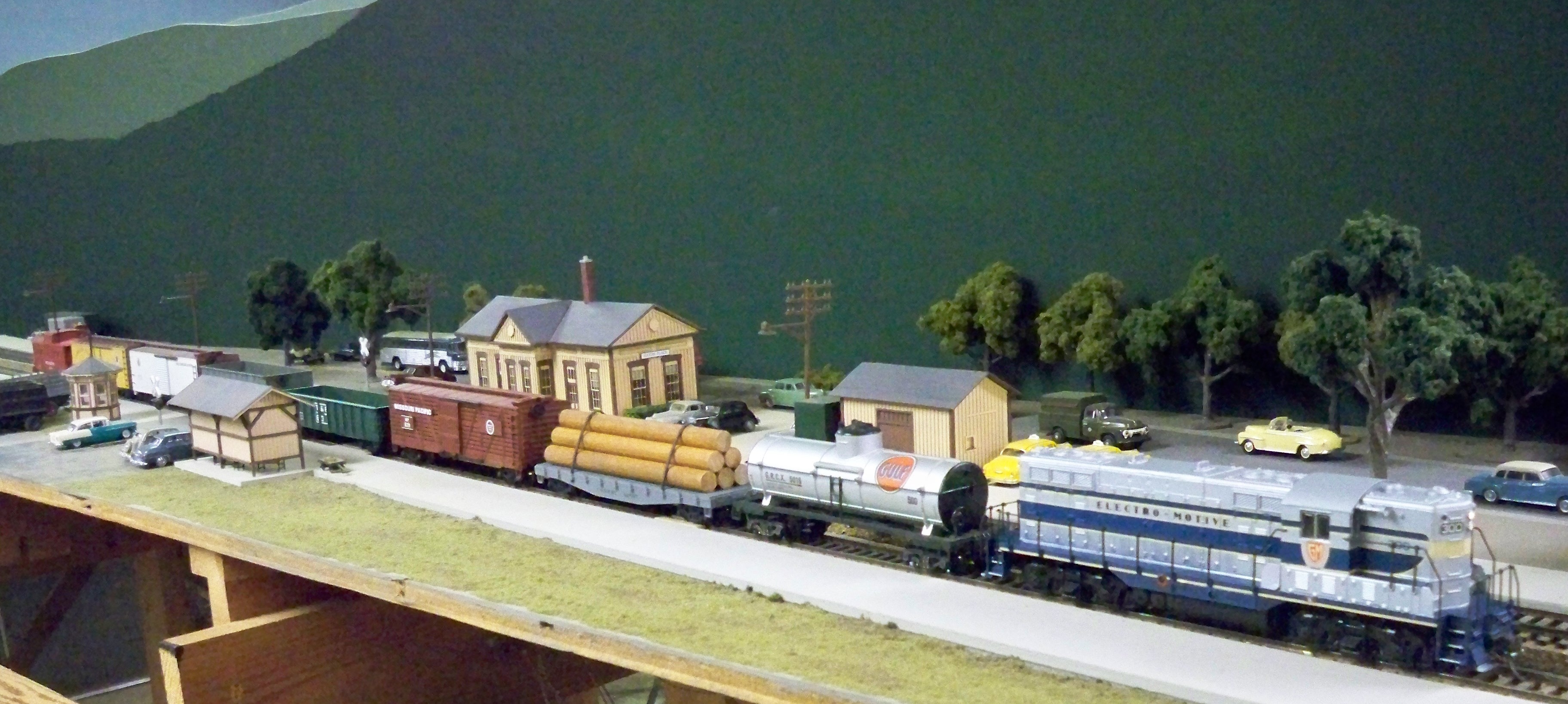
The first complete "Flyer look-alike" freight train,
with one of each of the eight basic freight car types, prowls the Alleghenies in
2014.
|
These
American Flyer S-scale cars...
(Photos in this column are of others'
equipment.
Photo sources other than the author are noted.) |
...are
represented by these Faux Flyer HO cars.
(All photos in this column are by the author
and of his own equipment.) |
|
|
CARS FROM GILBERT-HO
▼The
following three cars were manufactured either by or for Gilbert-HO.
They
are used without modification, except for installation of Kadee magnetic
couplers for operational compatibility. Even the 500-series numbers for Gilbert HO cars
have been left unchanged.
Cars made by Varney
used different casting dies from those used by Gilbert, but in most cases
were decorated similarly. |
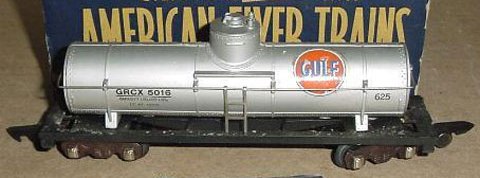
AF #625 / 925 Gulf tank car, GRCX 5016
(Photo courtesy of
The Gilbert Gallery)
(I owned one of these!)
The Gulf tank car was one of the few American
Flyer cars that displayed both a prototype car number and Gilbert's unit
number. As far as I know, no prototype Gulf tank cars were ever
painted aluminum; most, if not all, were black. |
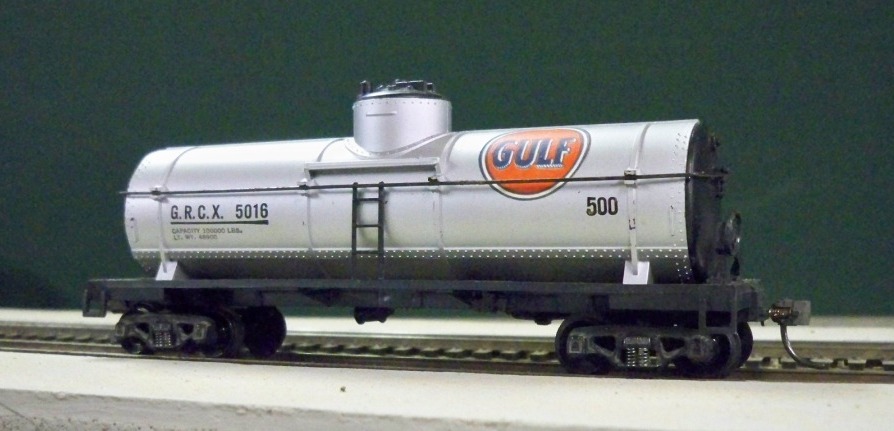
Gilbert-Varney #500 36' tank car, GRCX 5016 "Gulf"
(original, budget model, used)
Note that this Gilbert-Varney HO car has black
tank ends, dome cap, ladders, and handrails, whereas these components on the
American Flyer S-gauge car are the same aluminum color as the rest of the tank.
(Some HO units were produced without these black accents.) Some Varney
tankers (including the one above) were shipped without side ladders. I
corrected this before putting this car into service.
Varney-made tank cars (above) were a scale 36
feet long with standard frames, whereas Gilbert-made tankers (below) were a
scale 40 feet with fish-belly center beam frames. |
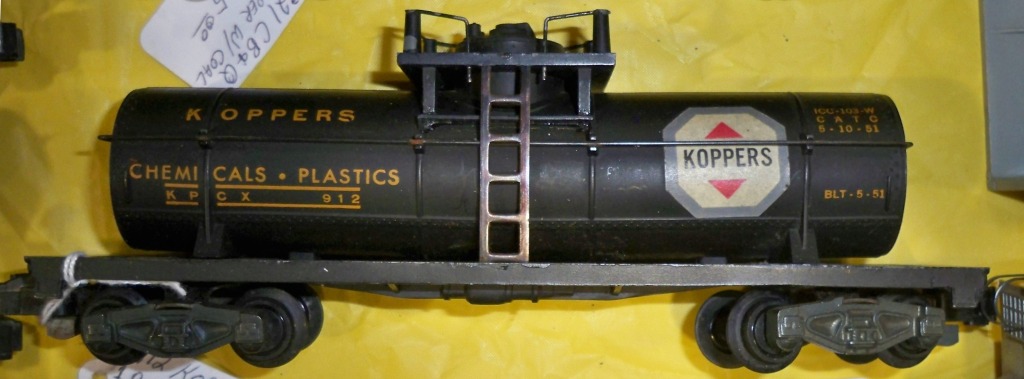
AF #912 Koppers chemical tank car
(Photo by author, Dayton Train Show 2015)
This black Koppers car was the second of
American Flyer's chemical tank cars. (The first, #910 bearing the
fictitious "Gilbert Chemicals" name, was discontinued after only one year.) Although Flyer had made oil-refinery tankers
early on, it did not produce a chemical version of the car until 1954, after
the changeover to knuckle couplers. Hence, there were no chemical
tankers in Flyer's 600 numbering series. |
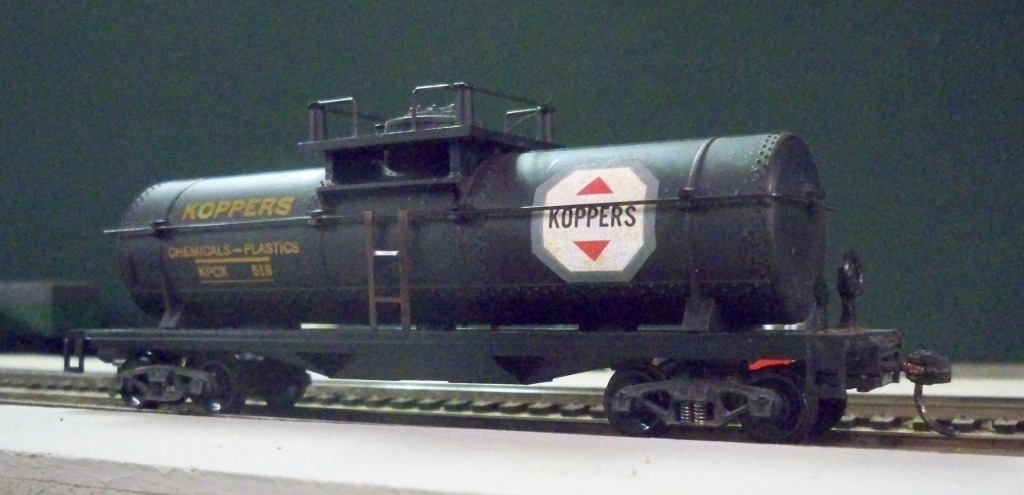
Gilbert-HO #518 40' chemical tank car, KPCX "Koppers"
(original, medium-grade toy, r-t-r)
I acquired this car at a swap meet in early
2016. Although the Gilbert-HO car is similar to the S-scale tanker,
subtle differences include the ladder height, frame type (standard on the S
car, versus fish-belly on the HO), dome vent details, and dimensional data. |
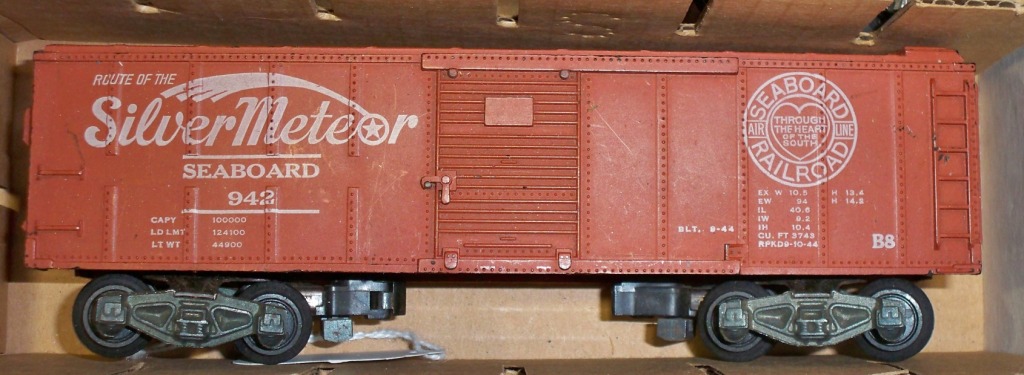
AF #642 / #942 SAL "Silver Meteor" box car
(Photo by author, Dayton Train Show 2015)
This was among the first of American Flyer's
die-cast postwar box cars to be produced in a prototype paint scheme.
There was also an action version of this car, featuring a man pacing to and fro
along the roof walk. |
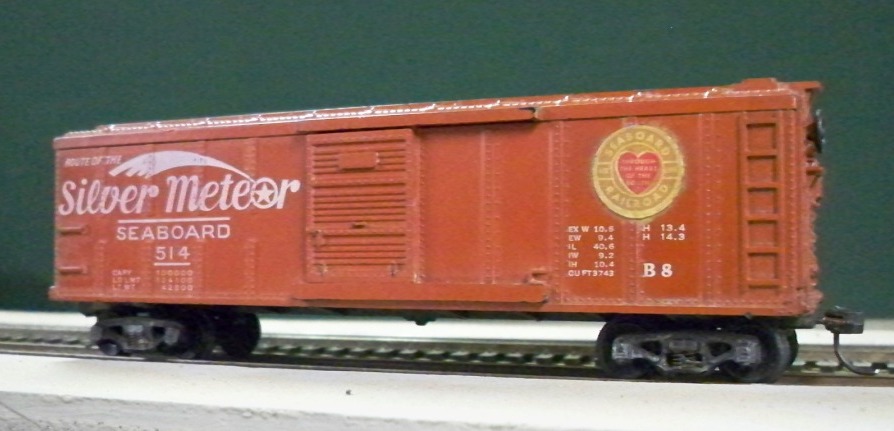
Gilbert-HO #514 40' box car, SAL "Silver
Meteor"
(original, medium-grade toy, r-t-r)
This was my first piece of HO rolling stock,
acquired about 1960, as I was in the process of trading in my S-gauge
American Flyer equipment.
This Gilbert unit is very
primitive: no corner steps, grossly oversize door guides, crude and
inaccurate details all over, and topped off with a stick-on paper "Seaboard"
herald. Only the sprung Bettendorf trucks look fairly prototypical.
The car looks quite out of place with the better detailed equipment I've purchased
since. However, I keep it in the Faux Flyer roster for old times'
sake. |
|
In later years, Gilbert
outsourced much of its HO production to other manufacturers.
Gilbert-made cars looked more like Flyer S, but Varney-made cars were more
prototypically accurate. |
|
|
CARS FROM OTHER MANUFACTURERS
▼The following HO models have been selected
and modified to resemble American Flyer S-scale
equipment, using Flyer's (in some instances non-prototypical)
paint schemes and numbers.
(Listed in approximate order of production by American
Flyer—except the caboose, which marked the end of virtually every American freight train in
those days.) |

AF #628 Chicago & North Western "log car" 42597
(Photo by author, Dayton Train Show 2014)
(I owned one of these!)
The C&NW flat car was one of a few cars that
displayed prototype car numbers instead of American Flyer unit numbers.
It displayed little else, aside from reporting marks. Prototype CNW
flat cars were oxide red with white lettering. (That they ever hauled
stained wooden dowels is probably as fictitious as the gray color.) |
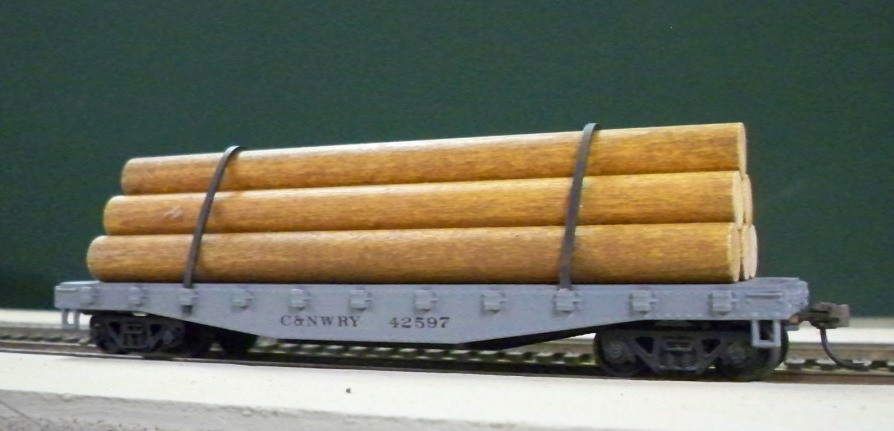
Athearn 40' flat car with log load, C&NW 42597
(redecorated, budget model, kit)
For the "log" load, I used 3/8" diameter basswood dowels
with walnut stain. The tie-down straps are Evergreen styrene strips
painted black.
Paint: Polly Scale CSX gray.
Decals: Microscale 90002 black "Railroad Roman" alphabet set. |

AF #629 / 929 Missouri Pacific "cattle car"
(Photo by author, Dayton Train Show 2014)
(I owned one of these!)
Some versions of the Flyer stock car had
prototypical slots in the sides, whereas the only open slots on this one are
in the doors. My guess is that the manufacturer decided to close the
slots, either because open-slotting increased production costs, or because a
slotted body didn't have enough strength to withstand rough use as a toy. |
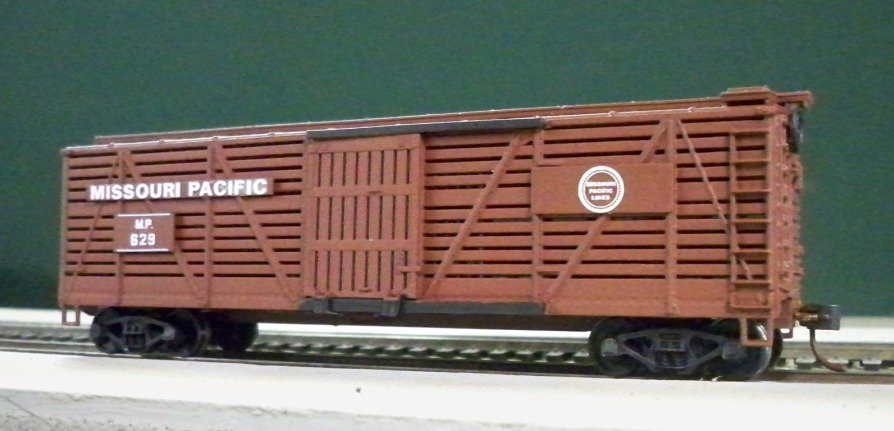
Trainline 40' composite stock car, MP 929
(redecorated, high-grade model, r-t-r)
This is the only high-grade model in the Faux
Flyer fleet, since it was the only model available that conformed acceptably
to Gilbert's design—never mind that the diagonal bracing goes in the
opposite direction!
Paint: Polly Scale (mix):
mineral red + caboose red.
Decals: Microscale 87-189; Westerfield 8801. |

AF #631 / 931 Texas & Pacific gondola
(Photo by author, Dayton Train Show 2013)
(I owned one of these!)
Prototype T&P gondolas were painted black with
white lettering. The dark green was the toymaker's choice, presumably
to add a bit more seasonal color to Christmas-tree displays. Flyer at
least saw fit to print loading data on this car. |
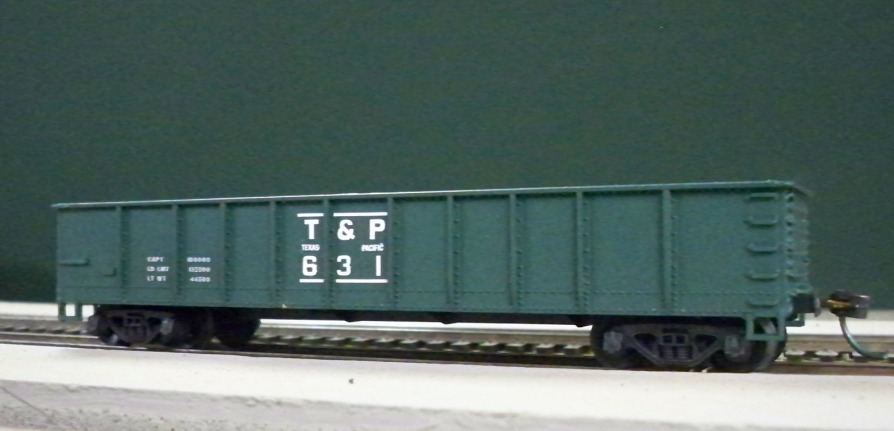
Mantua 40' 11-panel gondola, T&P 631
(redecorated, budget model, used)
The Mantua 11-panel gondola is a close match to
the Flyer car. However, the American Flyer gon has full ladders,.
For this Faux Flyer copy, though, I left the bare climbing rungs,
true to the T&P prototype.
Paint: Polly Scale (mix): 10 parts sylvan green
: 1 engine black.
Decals: Microscale 87-183, 90051 white "Block Gothic" alphabet set, 91111
(data). |
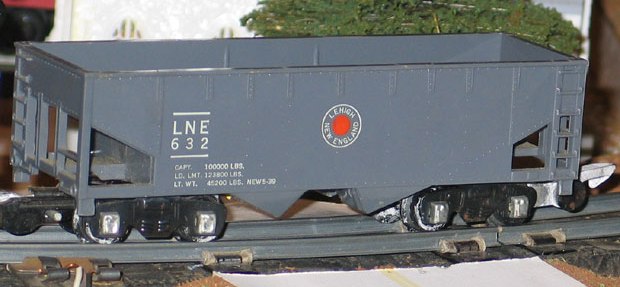
AF #632 Lehigh & New England hopper car
(Photo courtesy of
The Gilbert Gallery)
(I owned one of these!)
Prototype LNE hoppers were painted black.
Flyer chose gray instead, apparently feeling black (on anything other than a
steam locomotive) would be too gloomy. |
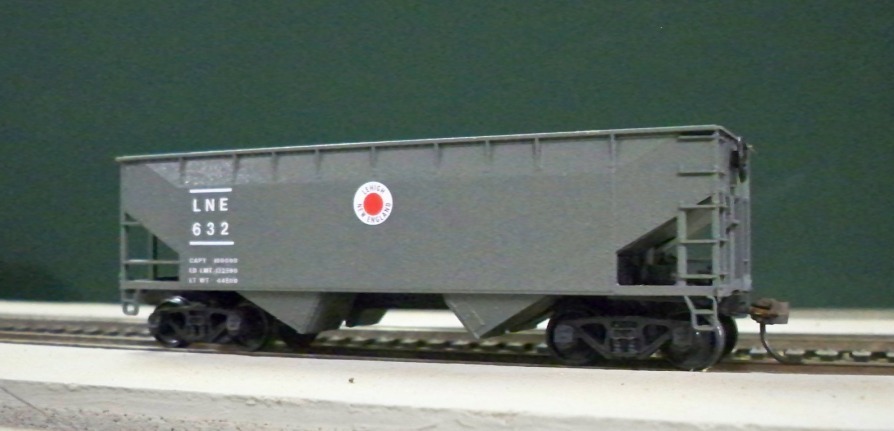
Athearn 34' 2-bay flat-end offset-side hopper car, LNE 632
(redecorated, budget model, kit)
Paint: Modelflex NYC light gray #1.
Decals: Microscale 87-2 (data); 87-882 (heralds); 90101 (markings). |
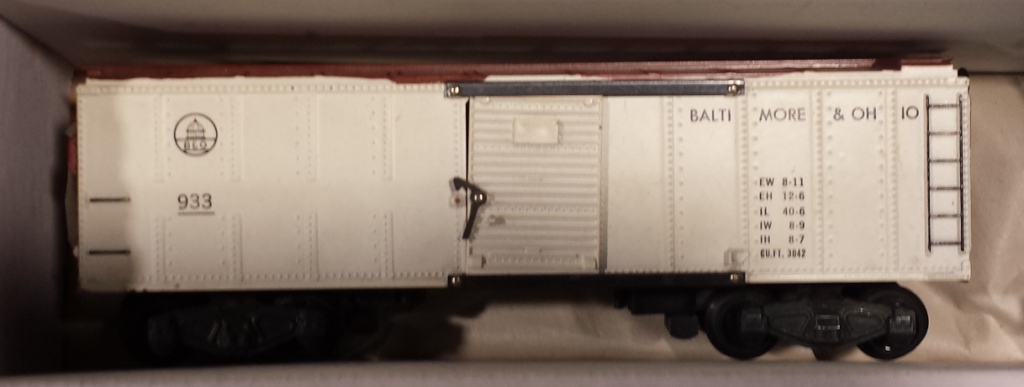
AF #633 / 933 Baltimore & Ohio box car
(AF also produced #633 B&O box cars in red with white or silver lettering.)
(Photo by author, Dayton Train Show 2014)
(I owned one of these!)
Although in shape and proportion this car resembles some of the ARA box
cars run by the real B&O, the prototype box cars were typically painted in
varying shades of oxide red with white lettering, or in a few cases in the
flashy Sentinel and Time-Saver schemes—never in brown-over-white. This
color scheme was entirely concocted by Gilbert, and slightly variable, with
ladders and grabs white on some cars and black on others. It was also
skimpy on markings: no reporting marks or load capacities, but only some dimensional data. |
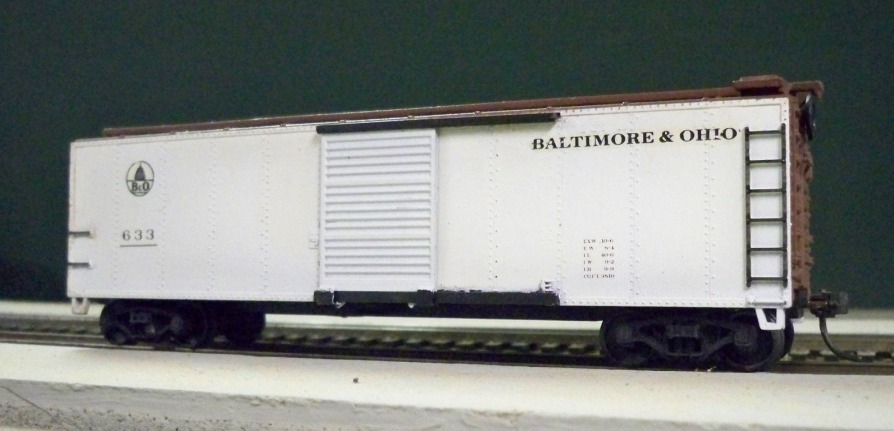
Train Miniatures 40' ARA box car, B&O 633
(redecorated, budget model, kit)
This ARA car, with Youngstown doors and
Dreadnaught ends, is similar to the American Flyer box car.
However, since there was no prototype for the
brown-over-white paint scheme on the real B&O, it took a while
to find an appropriate set of black decals for it.
Paint: Polly Scale light freight car red (roof &
ends); Modelflex antique white (sides). Door rails, ladders, and grab irons
blackened with felt-tip pen.
Decals: Champ HN-99; Microscale 87-2 (data). |
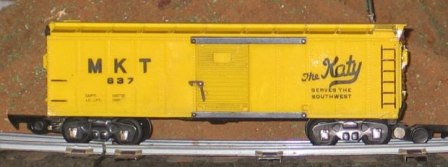
AF #637 Missouri, Kansas & Texas "Katy" box car
(Photo courtesy of
The Gilbert Gallery)
(I owned one of these!)
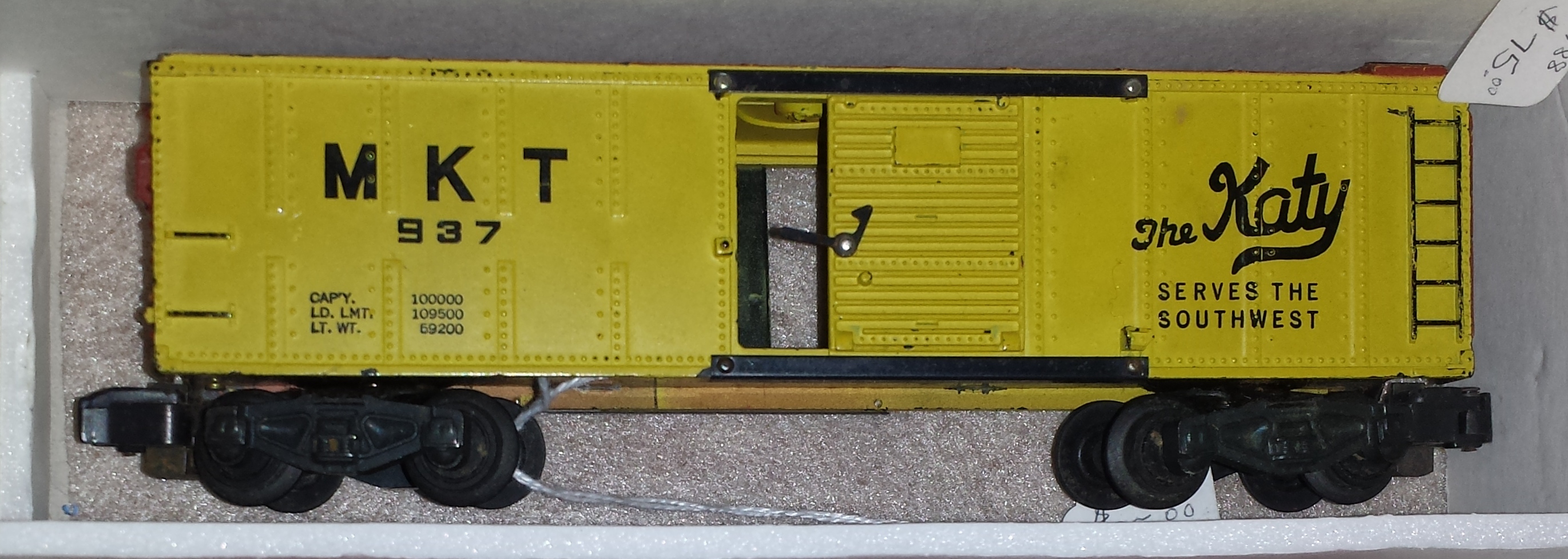
AF #937 Missouri, Kansas & Texas "Katy" box car
(Photo by author, Dayton Train Show 2014)
The real MKT operated many box cars in typical freight-car red with white
lettering. However, it did up a few with yellow sides and black
lettering, though the roofs and ends remained red.
Flyer's 637 and
early 937 MKT box car bodies were yellow all over—sides, ends, and roofs.
Later 937s (as in the lower photo) were two-toned with red roofs and ends,
as on the prototype.
|
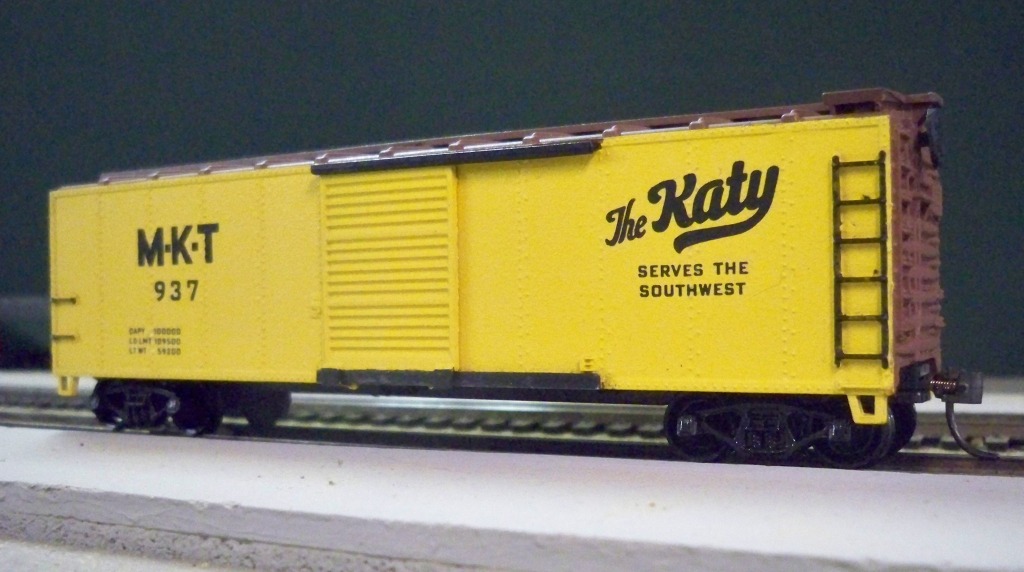
Train Miniatures 40' ARA box car, MKT 937
(modified, budget model, kit)
In 2014, I acquired another Train Miniatures ARA
boxcar with the correct
details to simulate a Flyer box car, and in 2016 I located an appropriate
decal set on eBay. I was originally inclined to model the all-yellow
637 (which was what I'd had in my AF fleet), but decided to go with the more
prototypical red-over-yellow 937. I could always paint the roof and
ends yellow if I changed my mind, and it would just represent the earlier
version of the 937.
Note "The Katy" lettering is located higher on
this car than on the AF car shown. However, a few AF Katy boxcars had
this lettering in the higher position, which was closer to prototype
practice allowing space for dimensional data below the logo.
Paint: Modelflex reefer yellow sides, with
original TM boxcar red roof and ends. Door rails, ladders, and grab irons
blackened with felt-tip pen.
Decals: Champ HB-1. |
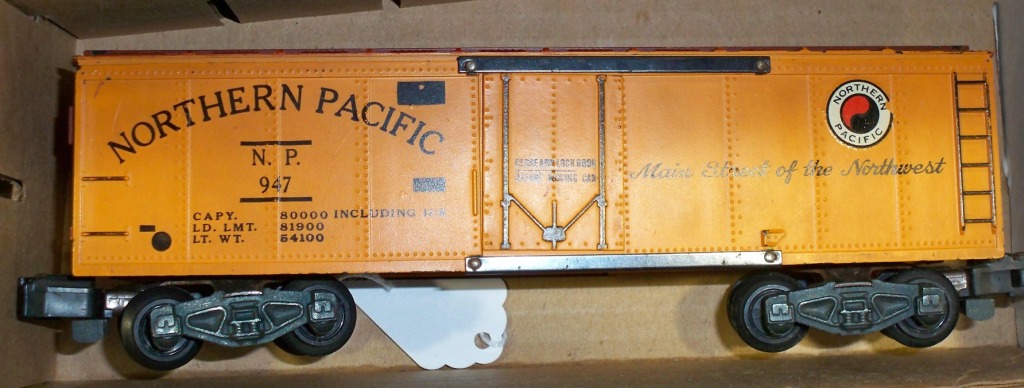
AF #647 / 947 Northern Pacific refrigerator car
(Photo by author, Dayton Train Show 2013)
Now here's a Flyer car in prototype colors!
The NP reefer was, to my eyes, one of the most strikingly good looking cars
in American Flyer's early freight fleet.
I never owned a Flyer reefer, but I sort of
"need" one in order to complete a set of basic freight car types. So
now I have an HO look-alike for a Flyer car I never had. |

Trainline 40' plug-door refrigerator car, NP 647 "Main Street of the
Northwest"
(redecorated, budget model, used)
The car's original 1940s metal-grid roof walk
was swapped for a 1930s wood-plank one to match Flyer's anachronistic
design.
Paint: Polly Scale light freight car red;
Modelflex UP Armor yellow + reefer orange mix. Door
rails and mechanism, ladders, and grab irons blackened with felt-tip pen.
Decals: Microscale 87-488 |

AF #911 Chesapeake & Ohio gondola with pipe load
(Photo by author, Dayton Train Show 2013)
By 1953, American Flyer had gotten over its postwar
aversion to black and other dull prototype colors. At the
same time, however, some prototype paint schemes were getting flashier. But changing
from oxide red to satin black was C&O's idea of "flashy."
Still, the pipes jazz it up a notch.
There are only 6 pipes in the American Flyer
car's load. The area below the car sill, which might appear to contain
3 more pipes, is instead occupied by a filler block.
Over the years of production, Flyer used various
colors for the pipes—aluminum, gray, even red. Late versions of this
car (1958 and later) featured yellow lettering and a stripe along the bottom
of the side, following the prototype C&O's evolving freight-car art. |
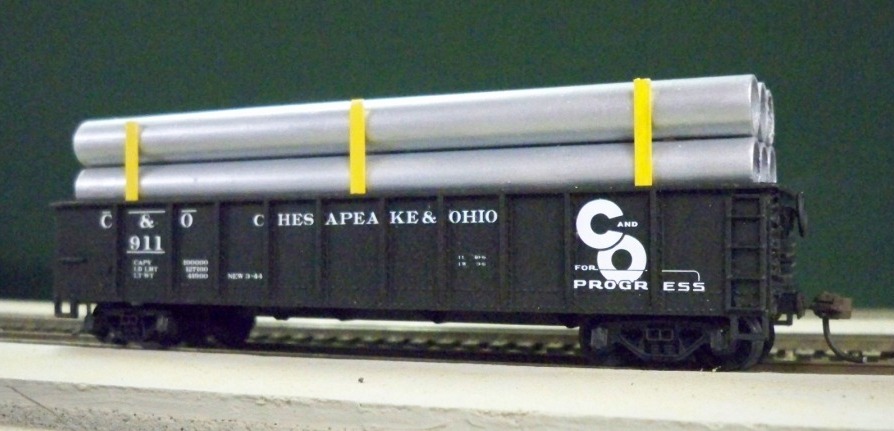
Mantua 40' 11-panel gondola, C&O 911
(redecorated, budget model, used)
For the C&O gon, I decided to grind off Mantua's
bare climbing rungs and add full ladders to match Flyer's configuration.
The full 9-pipe load in this car is Evergreen 3/8" diameter styrene tubing, resting on
3/32" stripwood to clear the car's interior bracing.. The 0.030"
thick styrene
stakes make for a snug fit to hold everything in place.
Paint: Modelflex engine black
(car), reefer yellow (stakes); Polly Scale flat aluminum (pipes).
Decals: Microscale 87-1045.
(This decal set is for a hopper car, and the "C&O for Progress" herald is
aesthetically too large for the gon. Still, it fits the available
space—barely.)
|
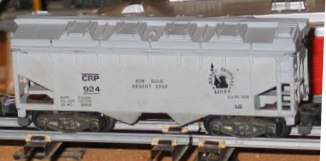
AF #924 Central of New Jersey cement car
(Photo courtesy of
The Gilbert Gallery)
This is one American Flyer freight car that
defies duplicating in HO scale! As far as I'm aware, there never was a
prototype for it. In the 1940s, prototype railroads first experimented
with covered hopper designs by applying hatch roofs to standard open-top
hopper cars. This would enable transport of bulk products that had to
be kept dry—e.g., cement, flour, grain—without the laborious and
time-consuming loading and unloading of box cars by men with shovels, as had
been the practice for such loads until that time.
However, the cars used for these experiments
were typically outside-braced—either vertically ribbed or composite truss
designs, not the more capacious but somewhat weaker offset-side design.
The extra strength of outside bracing was important because of the greater density of bulk cement compared to coal.
Flyer's problem was that the
only hopper car in its S-gauge roster at the time was an offset-side
model. So that's what was used, prototypical or not. Also
odd about Flyer's car were the reporting marks. All prototype Jersey
Central cars I've seen had "CNJ" markings; I've
never come across one lettered for "CRP." But that's what
Flyer
used, and so have I. |
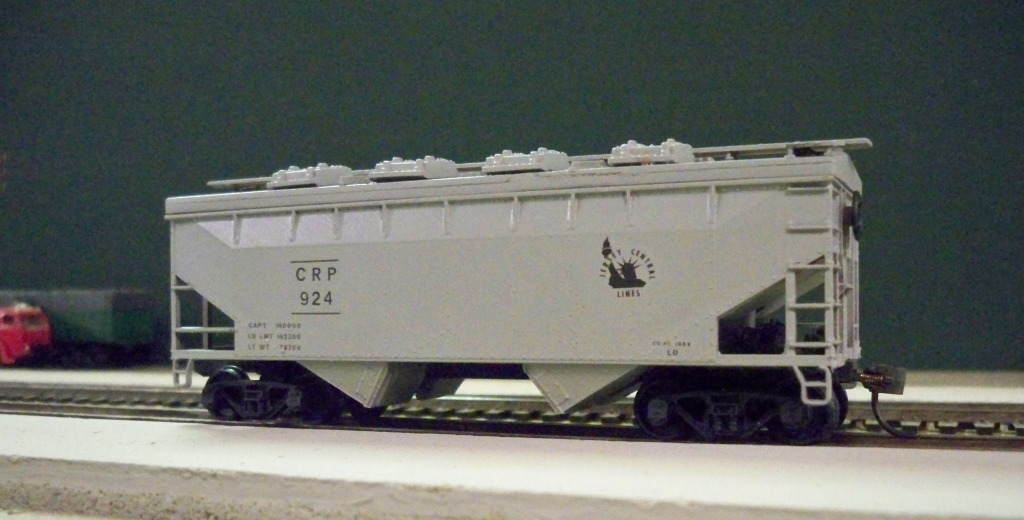
Athearn 34' 2-bay flat-end offset-side hopper car, CRP
924
(budget model, new, modified with
scratch-built 8-hatch roof)
As with my other Faux Flyer hopper cars, the
cement car is based on a stock Athearn open-top, offset-side
hopper. I imitated the Flyer add-on roof, using a Camino milled basswood roof-and-floor kit, plus some Plastruct styrene "T" stock
for the roof bracing, but omitting the five small edge braces along each
side of the roof, judging
them too tiny for my clumsy old fingers to deal with.
I initially
thought of using strip wood or styrene to build up a crude approximation of the
rectangular roof hatches. But then I decided to check my discard bin,
where I found an old Varney covered hopper. I cut the hatches from the
roof, and rubber-cemented them into place on my Faux Flyer unit.
Paint: Modelflex CB&Q gray
Decals: Microscale 87-231 ("Liberty" heralds); 87-1 (data); 90102 (Gothic letters,
numbers).
|
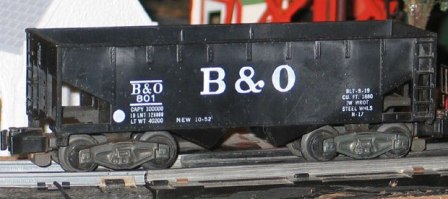
AF #801 Baltimore & Ohio hopper car
(Photo courtesy of
The Gilbert Gallery)
Did you happen to notice this car number seems out
of sequence? That's because Flyer opened the sparsely populated 800 series
when the rapidly filling 900 series was about to overflow in 1956-57. So
no, I haven't gone dotty. Newer production cars were added to the
lower-numbered series. The cars are in chronological production
order, even if not numerical. |
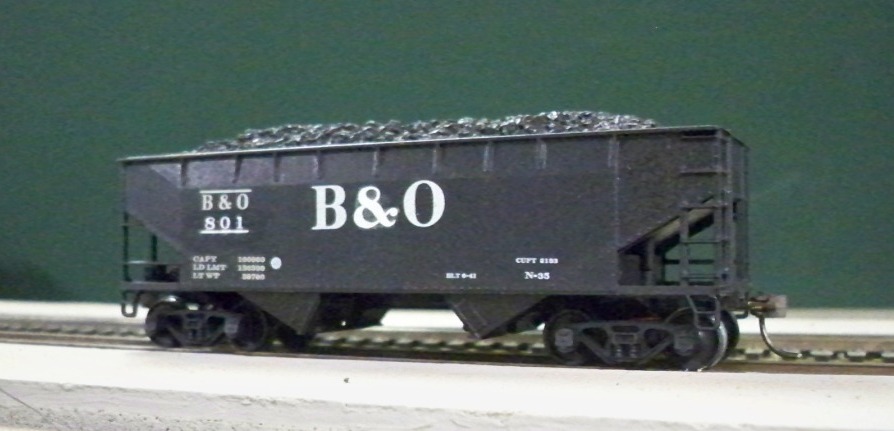
Athearn 34' 2-bay flat-end offset-side hopper car, B&O 801, with coal load
(redecorated, budget model, kit)
I'd already borrowed this car from the model
roster for the "Hand-Me-Down" phase. So, all I had to do to make this
a permanent Faux Flyer unit was change the number. Good enough!
Paint: Floquil engine black.
Decals: Champ HC-77. |
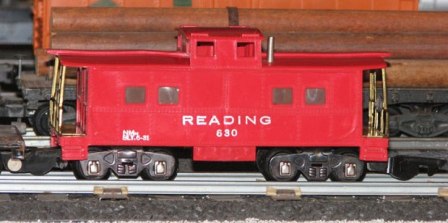
AF #630 Reading caboose
(Photo courtesy of
The Gilbert Gallery)
(I owned one of these!)
Rather out of sequence both number-wise and
chronology-wise here, but appropriately bringing up the rear of this
freight consist. |
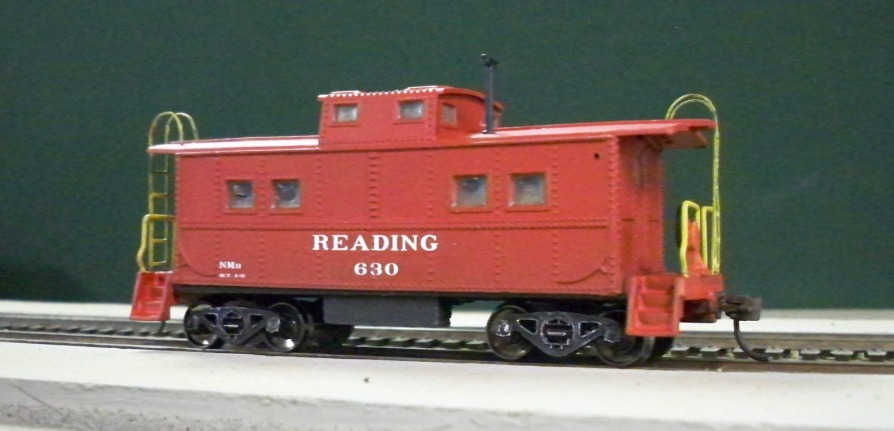
Varney centered-cupola steel caboose, RDG 630
(redecorated and illuminated budget model, used)
The faithful old caboose now has updated paint,
lettering, and interior lighting. The window glazing is Microscale
Kristal-Klear.
It's plausible that Reading cabooses might
sometimes appear on Baltimore & Ohio rails, since at one time B&O owned RDG,
and they shared trackage rights in some areas.
Paint: Polly Scale caboose red
(body), Armour yellow (handrails & ladders), engine black (trucks and underframe).
Decals: Microscale 87-883.
|
|
Passenger Cars
LOCOMOTIVES
| FREIGHT CARS
|
PASSENGER CARS
| STRUCTURES
|
The only American Flyer passenger cars I owned were from the standard
fleet, an assortment of Osgood-Bradley "New Haven" style cars and one
Pullman heavyweight observation car. I craved a streamlined
passenger set, like the ones that dazzled me as they daily whooshed
through town on the real New York Central, drawn by real Hudsons. But that wish was never granted. However, now I have
a reasonable facsimile in HO, so I'm not complaining!
|
Streamliners
Except for the dome car, I
can recall the scene below from real life, when NYC's
Ohio State Limited stopped at Winton Place (suburban Cincinnati) depot!
This photo also captures all four structures in the Winton Place ensemble
(craftsman laser-cut wooden kits by Mountaineers Precision Products).
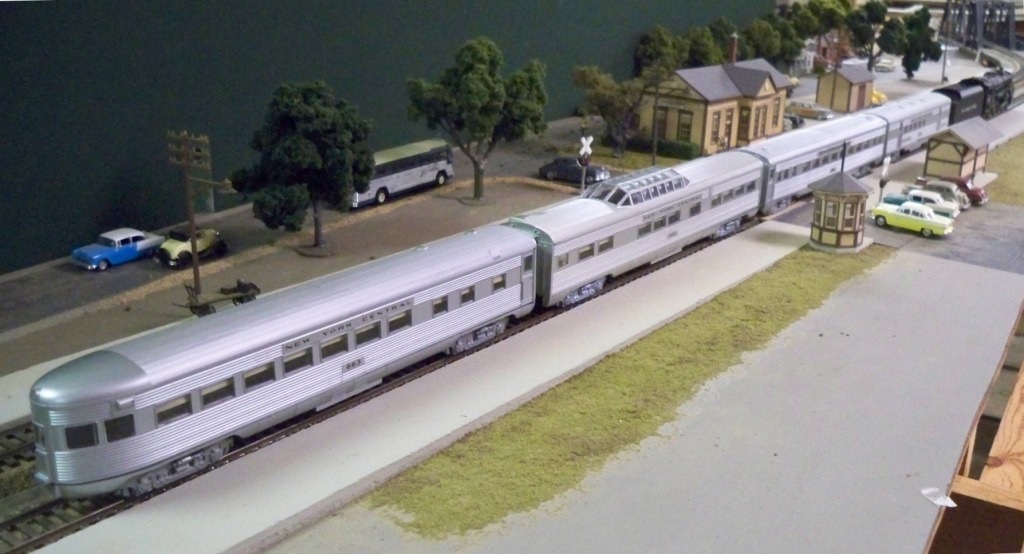
The Pacemaker streamliner, hauled by the
NYC Hudson, pauses to
load passengers at Haydn Place depot.
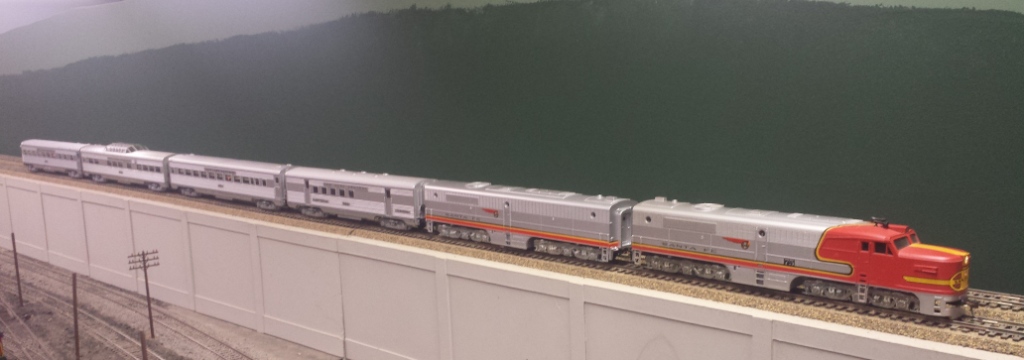
The Chief streamliner
roars along the viaduct toward Union Station.
All coupled up to
the Alcos, this four-car streamlined set makes a nice approximation of
American Flyer's Chief passenger set from the early 1950s, which
included the combine, dome, and observation cars, but not the coach (which
was available separately). The full set can be run only on the big
cellar layout. Just three of these cars are all that will fit behind
the single PA1 unit on the tiny Yule-tree layout, without fouling the switches for
the passing track.
In 1950, when American Flyer produced its first model of a passenger
diesel-electric locomotive (an Alco PA/PB-1), it also introduced a line of
four streamlined passenger cars to go with it: a combine, a coach, a vista
dome, and a round-end observation. The initial design of these cars generally
mimicked Budd prototypes, but were seriously flawed in details: The
side fluting unprototypically continued over the vestibule doors, which
had windows at the same level as the chair windows rather than at standing
eye-level. In 1952, these flaws were corrected, and a second lettering
board was added above the windows. In most cases, "American Flyer
Lines" was the name displayed on this upper board in both the 66x and 96x
series; however, a briefly produced 500-503 series bore the name "Pullman"
on the upper board, and "American Flyer Lines" on the lower. Eventually, the
streamliners even showed
up in a couple of the pricier steam passenger train sets, behind the UP
4-8-4 and the NYC 4-6-4.
Athearn's HO streamlined
passenger cars provide a visually pleasing and adequate, if less than
perfect, match to American Flyer's four-car streamliner set.
Compromises include the following:
-
Athearn does not offer a
streamlined baggage-club combine, so I've substituted a postal car as an
aesthetic stand-in with a similar window-and-door pattern.
-
Most of American Flyer's streamliners
were lettered for American Flyer Lines.* There being no "American
Flyer" decals offered in HO scale, I applied American Flyer's car numbers,
but lettered the streamlined cars for New York Central (since the Hudson
was pulling them at the time).
-
Now that the Santa Fe Alcos
are hauling the streamliners, I'm contemplating re-lettering the cars for
Pullman (as was an uncatalogued 500-503 series of Flyer streamliners in
1952-53), so they can credibly be coupled
to locomotives from any major American railroad of the mid 20th century..
|
|

AF #660 streamlined baggage-club combine
(Photo:
http://www.thegilbertgallery.org) |
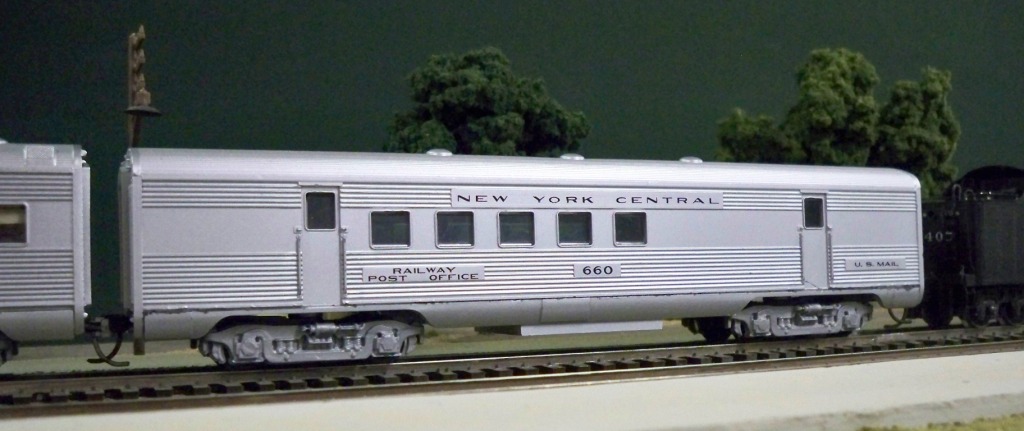
Athearn streamlined 60' RPO (railway post office) car, NYC 660
(budget model, used)
The previous owner cemented the body onto the frame, so there's no way of getting into it for adding
details or lighting, without risking significant damage.
|

AF #661 streamlined coach
(Photo:
http://www.thegilbertgallery.org) |
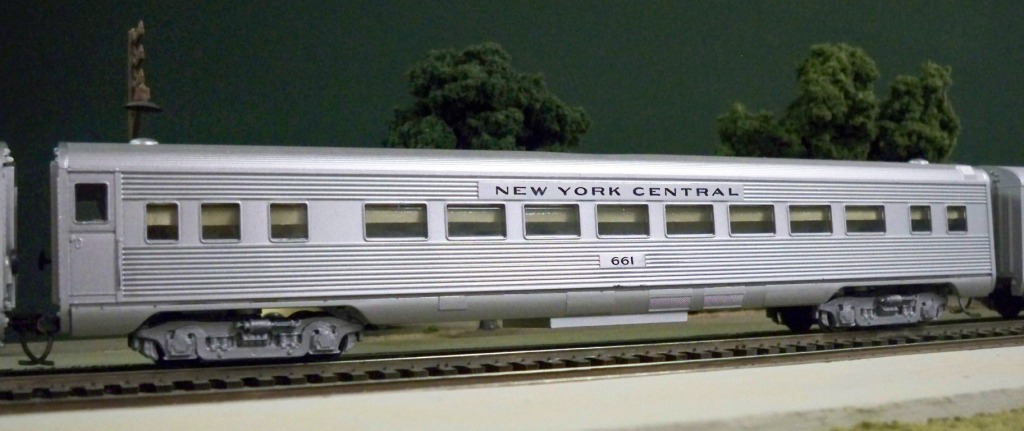
Athearn streamlined 70' coach, NYC 661
(illuminated budget model, used) |

AF #662 streamlined vista dome car
(Photo:
http://www.thegilbertgallery.org) |

Athearn streamlined 70' vista dome car, NYC 662
(illuminated budget model, used) |

AF #663 streamlined observation car
(Photo:
http://www.thegilbertgallery.org)
The American Flyer cars pictured above are from
the initial production of 1950-51. The retooled 1952 line corrected
the annoying flaws. |
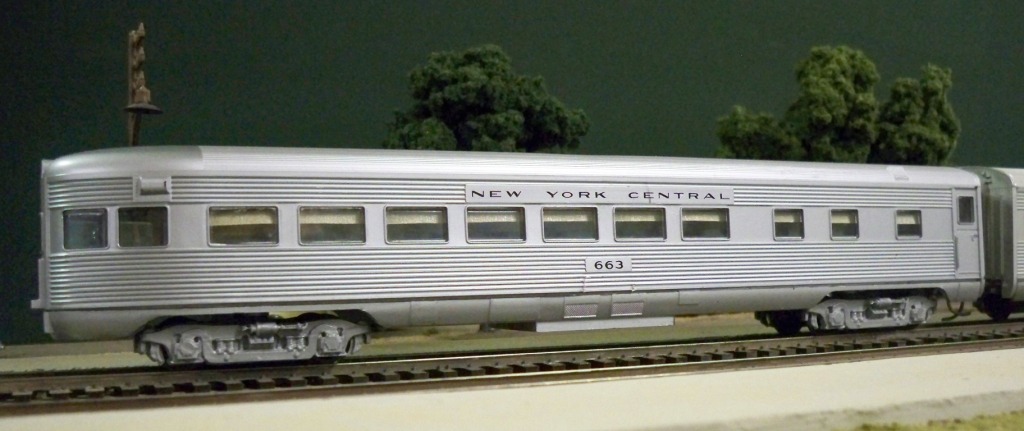
Athearn streamlined 70' observation car, NYC 663
(illuminated budget model, used)
Decals: Microscale 87-1352 (all streamlined
passenger cars). |
When I began acquiring cars for
the Faux Flyer streamliner in 2010, the project was still in "minimum cost"
mode, and second-hand Athearn cars were cheap and plentiful. During the "prototypes" phase of the project,
the NYC Hudson steamer was the sole passenger power available. I resisted the temptation to
add a dome car, since the prototype New York Central never operated them.
But since evolving to the "Flyer look-alikes" phase, the standard has been
revised accordingly, and I've relented.
Recently,
however, I've been looking at Tyco 70-foot "shorty" streamliners, which
are much closer to American Flyer designs, and which include a
baggage-coach combine. I'm now considering
replacing the Athearn streamline set with Tyco cars, assuming I can find some in
acceptable condition and at an agreeable price.
|
Heavyweights
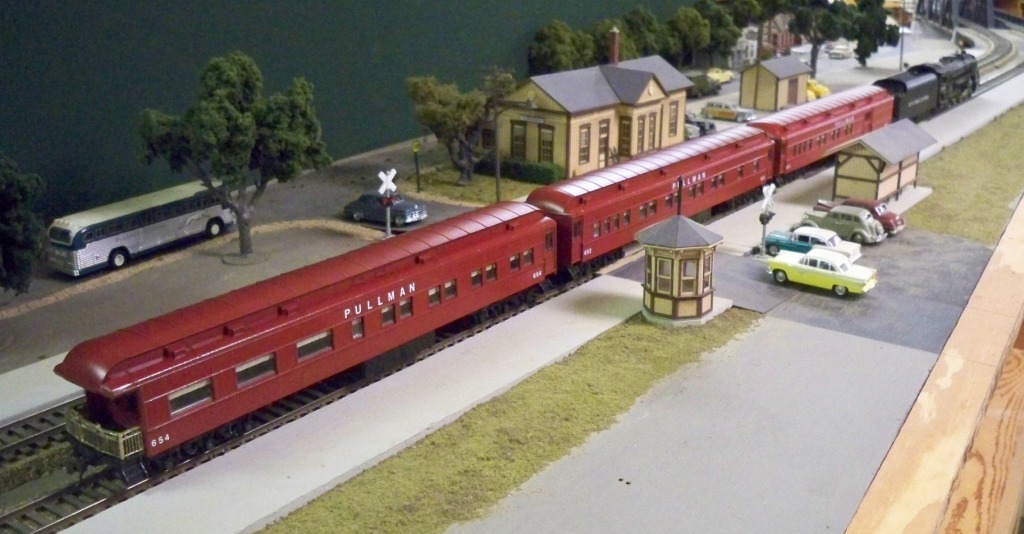
The Hudson pauses at Haydn Place with its three-car set of heavyweight Pullmans.
This consist resembles American Flyer set 4612 / 4613,
produced from 1946 to 1948, except that this train has only one sleeping
car, whereas the Flyer set had two. Even just three of these cars
are too long to fit on the tiny Yule layout behind the Hudson, without
fouling the switches for the passing siding. So, I use just two
of the cars on the small layout—though which two might vary from day to
day.
Heavyweight passenger cars are an afterthought for the
Faux Flyer project. I've already put together a complete
freight fleet, and a four-car streamlined passenger train. But wait!
As a boy, the only Flyer passenger cars I'd owned were the non-streamlined
"standard" variety. So, since the purpose of Faux Flyer is to lend
tangibility to my own childhood memories, I ought to be running the older
style cars. So that's been my focus in 2016.
American Flyer produced its standard passenger cars in
both red and green versions. My boyhood passenger set
had been green, and the prototype NYC ran green heavyweights behind
its Hudsons. So, in planning the Faux Flyer version, I'd intended to
use Sylvan Green as the base color for the set. However, three factors
ultimately caused me
to opt instead for red:
[1] in American Flyer's passenger train sets, catalogues show the Hudson locomotive
with red cars;
[2] if Faux Flyer should ever acquire an HO PRR Pacific, that Pennsy engine would
definitely look more at home with red cars; and
[3] on the little holiday layout, gleaming red cars traversing white snowscape would
offer a festive contrast to the dark green Yule tree.
And that's why the Faux Flyer set ended up red instead of green!
|
These American Flyer
S-scale cars...
(Photos in this column are of others'
equipment.
Photo sources other than the author are noted.) |
...are represented by these
Faux Flyer HO cars.
(All photos in this column are by the author
and of his own equipment.) |
|

AF #653 heavyweight baggage-club car
(#953 "Niagara Falls" pictured)
(Photo by author at Dayton Train Show.) |
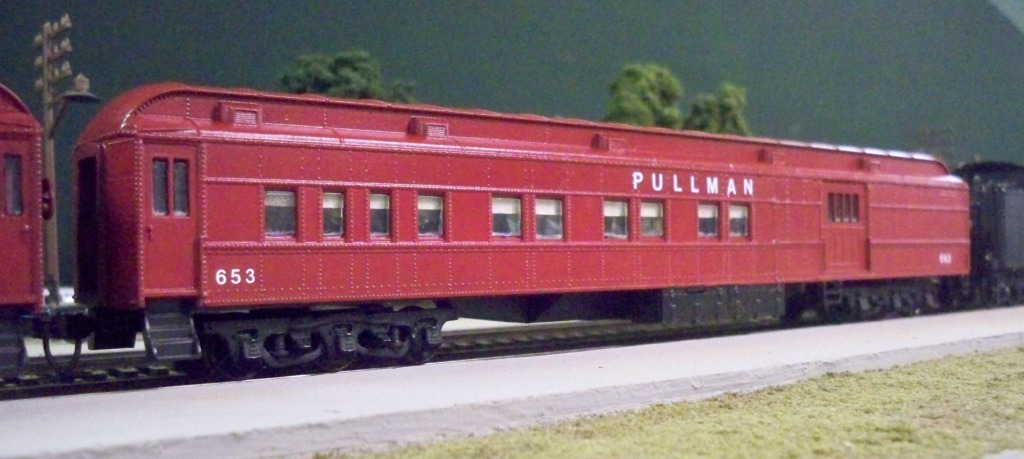
Athearn heavyweight 70' baggage-club combine,
Pullman 653
(budget model, kitbashed)
Athearn doesn't make a baggage-club combine, so I
cut up and spliced a
couple of used cars—a baggage car and a sleeper—to approximate Flyer's
head-end heavyweight. I've retained materials from the former sleeper
to replace the odd-spaced windows (near the vestibule end of the car) with an additional set of paired windows—if
I ever work up the courage to complete the transformation. |
|

AF #652 heavyweight sleeping car
(Photo by author at Dayton Train Show.) |
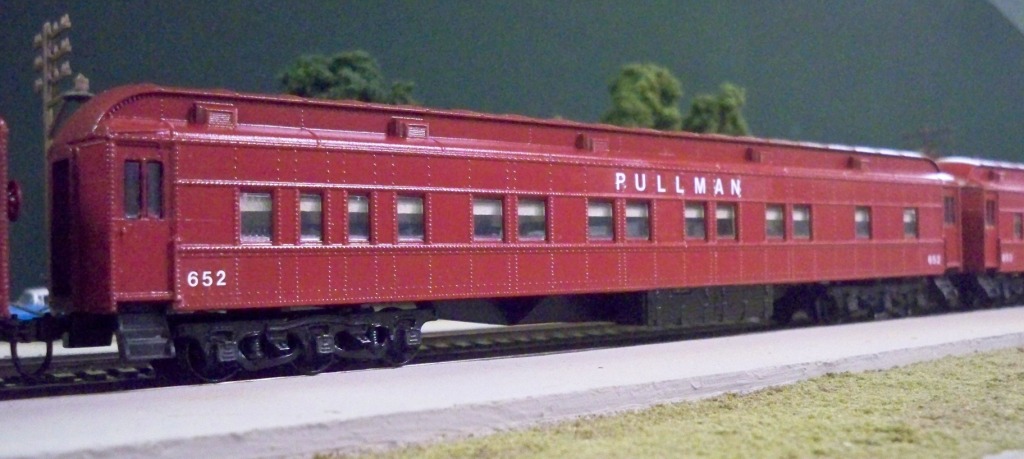
Athearn heavyweight 70' sleeper, Pullman 652
(budget model) |
|

AF #654 heavyweight platform observation car
(Photo by author at Dayton Train Show.)
The American Flyer cars in the
photos above look darker than they actually are, owing to the poor lighting
on the swap-meet display tables. As I recall, actual AF passenger car
colors varied considerably over the 12 years of production. Greens
swung from dark pine to a slightly bluish medium green, while the reds
fluctuated from a somber "Tuscan" to an exuberant "Ferrari." The red
on my Faux Flyer fleet, seen under "cool-white" fluorescent lighting, lies
somewhere between these extremes. |
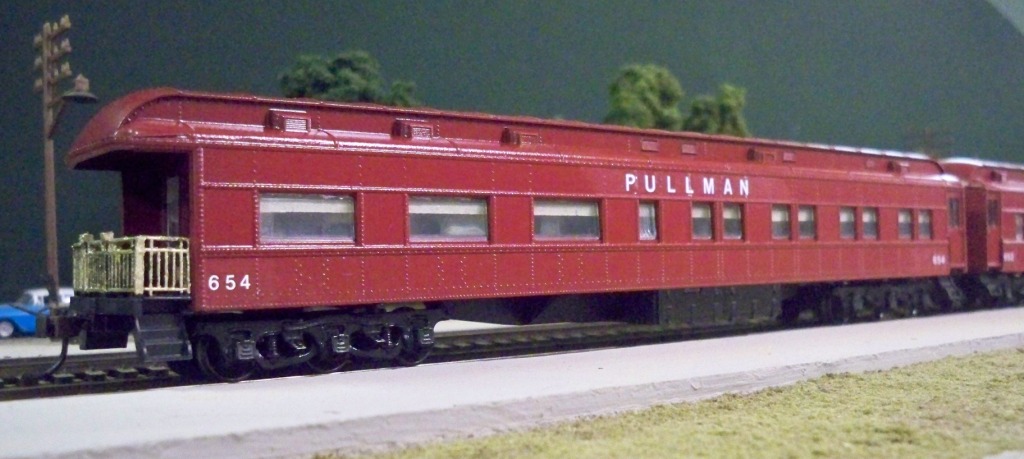
Athearn heavyweight 70' observation, Pullman 654
(budget model)
The Athearn cars' window dimensions and spacing
do not match American Flyer's. However, considering the less-than-expert
level of my modeling skills, a smooth if not entirely faithful overall
appearance is far preferable.
These cars do not yet have interior lighting,
but I hope to add this feature in time for the next holiday season.
Paint: Modelflex "Caboose Red" (body); Floquil
"Brass" (platform railing).
Lettering: Microscale 90101 "Railroad Gothic" white alphabet set.
Modelflex's caboose red is
somewhat
darker than its competitors' equivalents, and thus makes for a more
dignified appearance than the brighter shades produced by Floquil or Scalecoat.
Still, I've chosen to use a gloss finish, rather than matte, on these
"varnish" cars. |


